Sir Ian

“Older Actors Have Always Had Power”
MCKELLEN Antibiotic Crisis
THE LETHAL THREAT OF DRUG RESISTANCE
Seasonal Savings 7 Ways To Curb Your Christmas Spending MONEY
NOVEMBER 2019 £3.79 readersdigest.co.uk
HEALTH • MONEY • TRAVEL • RECIPES • FASHION • TECHNOLOGY READER’S DIGEST | SMALL AND PERFECTLY INFORMED | NOVEMBER 2019
NOVEMBER 2019

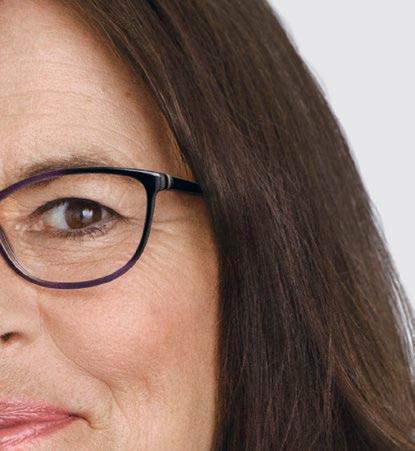









Features
16 IT’S A MANN’S WORLD
The claws are out as Olly Mann mediates an unexpected feline rivalry—Coco versus Alvin
ENTERTAINMENT
20 INTERVIEW:
SIR IAN MCKELLEN
Britain’s most beloved thespian on his illustrious career and colourful life
30 “I REMEMBER”: GLENN TILBROOK
The Squeeze singer on discovering his gifts and making a difference
HEALTH
40 ANTIBIOTIC CRISIS
Susannah Hickling explores the rise in European antibiotic resistance
INSPIRE
60 BEST OF BRITISH: FORAGING
The best places in the UK to don your wellies and gather a foraged feast
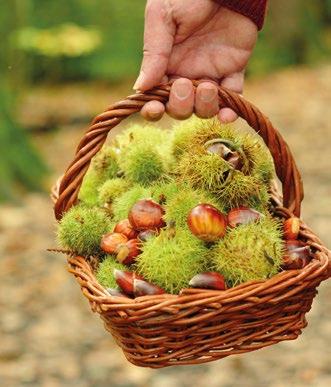

72 THE POWER OF TOUCH
Why physical contact is so important for our happiness, wellness and health
80 BLUE GIANTS
Step into the mysterious majesty of whale territory
TRAVEL & ADVENTURE
90 SWINGING CHICAGO
Simon Button steps back in time to enjoy jazz in the Windy City
2019 NOVEMBER 2019 • 1
Contents NOVEMBER
p80 p60 cover photograph by Sarah Dunn/Contour/Getty Images
Help us be there when people need us most

Gifts in wills are vital to all we do. A lifeline for a family whose home has been destroyed by an earthquake, company for an elderly person who hasn’t spoken to anyone in days or a much-needed meal for a hungry child fleeing a war zone.
Any gift you leave, large or small ensures we are there to help someone in need in their time of crisis. Please will you consider leaving a gift in your will?
The British Red Cross Society, incorporated by Royal Charter 1908, is a charity registered in England and Wales (220949) Scotland (SC037738) and Isle of Man (0752)
Find out how you can make or update your will using our free noobligation will writing service, or for any advice — please call 0300 500 0401 or visit redcross.org.uk/freewill
 Photo@TaliaFrenkel/AmericanRedCross Haiti 2010
Photo@TaliaFrenkel/AmericanRedCross Haiti 2010


NOVEMBER 2019 • 3 9 Over to You 12 See the World Differently HEALTH 48 Advice: Susannah Hickling 52 Column: Dr Max Pemberton INSPIRE 68 If I Ruled the World: Mick Hucknall TRAVEL & ADVENTURE 98 My Great Escape 100 Arctic Adventures MONEY 102 Column: Andy Webb FOOD & DRINK 106 Tasty recipes and ideas 110 FASHION & BEAUTY 114 Column: Lisa Lennkh on how to look your best 116 Beauty ENTERTAINMENT 118 November’s cultural highlights BOOKS 122 November Fiction: James Walton’s recommended reads 127 Books That Changed My Life: Caroline Kepnes TECHNOLOGY 128 Column: Olly Mann FUN & GAMES 130 You Couldn’t Make It Up 133 Word Power 136 Brain Teasers 140 Laugh! 143 60-Second Stand-Up 144 Beat the Cartoonist In every issue p106 Contents NOVEMBER 2019

Did you know that one in four adults aged 55 and over tell no one if they’re struggling with
their mental health?
Leading UK health insurer, Bupa, has found baby-boomers are neglecting their wellbeing. They want to help more people access support for mind and body.
An issue that shouldn’t be ignored
Two thirds of the over 55s reported experiencing mental health issues. Yet, many keep quiet. One in four (27%) tell nobody, with fewer confiding in a partner or friend than younger generations and less than half consulting a doctor.1 Even those who do seek help delay by over 50 days on average.
Why they feel unable to act
Lack of action stems from a lack of awareness that the symptoms could indicate a mental health problem. Less than one in three over 55s feel confident in recognising the symptoms, compared to nearly half of 18-34-year-olds.2
Opinium Research conducted among 2,152 UK adults, 19-22 March 2019.
How Bupa can help
Not only do Bupa cover more mental health conditions than any other leading UK health insurer†, they provide continued support from specialists through life’s ups and downs.
READER OFFER
To help support more people in mind and body, Bupa offer 10% off* Bupa By You health insurance. To get a quote, call 0808 302 4214 or visit bupa.co.uk/ readers-digest
184% of 18-34-year olds tell at least one person about their symptoms. 43% tell a partner and 50% tell a friend, compared to 33% and 28% respectively for over 55s.
231% of over 55s said they were fully aware of depression and 26% are fully aware of anxiety, compared to 46% and 46% respectively for 18-34s.
†As of May 2019, based on internally conducted research of the consumer health insurance market. Refers to standard mental health cover when this is included in the selected health cover product.
*Applies to Reader’s Digest members on quotes for new Bupa By You policies. Discounts will be reviewed on 10/09/2020 and any changes will apply to renewals and new quotes thereafter. Quotes are valid for 14 days. T&Cs apply.
Reader’s Digest introduces Bupa health insurance. Bupa health insurance is provided by Bupa Insurance Limited. Bupa Insurance Limited is authorised by the Prudential Regulation Authority and regulated by the Financial Conduct Authority and the Prudential Regulation Authority.
PARTNERSHIP PROMOTION
Insurance
by
Arranged and administered by Bupa
Services Limited, which is authorised and regulated
the Financial Conduct Authority.
SENIOR EDITORS Anna Walker, Eva Mackevic
EDITORIAL ASSISTANT Jessica Summers
ART DIRECTOR Richard Cooke
ADVERTISING Jigs Pankhania
MARKETING Sarah Hughes
HEAD OF FINANCE Santwana Singh
FINANCE MANAGER Irving Efren
MANAGING DIRECTOR Julie Leach
CHAIRMAN Gary Hopkins
subscriber enquiries, please
WE PAY...
£50 for the star letter and £30 for regular letters.
Email readersletters@readers digest.co.uk or go to readers digest.co.uk/contact-us
WE ALSO PAY...
£30 for the true stories, anecdotes, jokes in Laugh! and You Couldn’t Make It Up…, and contributions to end-ofarticle fillers and My Great Escape.
Email excerpts@readersdigest.co.uk or go to readersdigest.co.uk/contact-us
SORRY!
We cannot acknowledge or return unpublished items or unsolicited article-length manuscripts. Do not send SAEs. Article-length stories, poetry and cartoons are not requested.

TRUSTED MEDIA BRANDS INC (USA)
President and Chief Executive Officer
Bonnie Kintzer
Vice President, Chief Operating Officer
International
Brian Kennedy
Editor-in-Chief, International Magazines
Raimo Moysa
number below
CUSTOMER SERVICES
Contact Customer Services for renewals, gifts, address changes, payments, account information and all other enquiries. Call 0330 333 2220* or email customer_service@readersdigest.co.uk
TALKING MAGAZINES
Reader’s Digest is also available in audio and accessible etext editions from RNIB Newsagent, for blind and partially sighted readers. Call the RNIB Helpline on 0303 123 9999 or visit rnib.org.uk/newsagent
SUBSCRIPTIONS
Annual subscriptions are available to be delivered monthly direct to your door. For our latest offers please visit readersdigest.co.uk/subscribe Or telephone us today on 01778 392461
Gift subscriptions also available. UK rates may vary. Overseas rates: Republic of Ireland €50, Rest of the World €60.
*Calls to 03 numbers cost no more than a national rate call to an 01 or 02 number and will be free if you have inclusive minutes from any type of line including mobile, BT or other fixed line PAPER FROM SUSTAINABLE FORESTS. PLEASE RECYCLE © 2017 Vivat Direct Ltd (t/a Reader’s Digest). British Reader’s Digest is published by Vivat Direct Ltd, 57 Margaret Street, London W1W 8SJ. All rights reserved throughout the world. Reproduction in any manner, in whole or part, in English or other languages, is prohibited. Reader’s Digest is a trademark owned and under license from Trusted Media Brands, Inc, and is registered with the United States Patent and Trademark Office. All rights reserved. Printed by Pindar Scarborough Limited. Newstrade distribution by Seymour Distribution Limited. SMALL PRINT: Ensure submissions are not previously published. Include your name, email, address and daytime phone number with all correspondence. We may edit letters and use them in all print and electronic media. Contributions used become world copyright of Vivat Direct Ltd (t/a Reader’s Digest). Reader’s Digest is a member of the Independent Press Standards Organisation (which regulates the UK’s magazine and newspaper industry). We abide by the Editors’ Code
Practice
committed
upholding the highest standards
journalism.
met those standards,
contact 0203
IPSO
Editors’ Code, contact IPSO
0300 123 2220 or visit
OUR
of
and are
to
of
If you think that we have not
please
795 8886. If we are unable to resolve your complaint, or if you would like more information about
or the
on
ipso.co.uk For all
use the customer services
WRITE TO US! SEND US YOUR STORIES, JOKES AND LETTERS OR VISIT
WEBSITE
5
More and more homeowners over the age of 55 are releasing equity from their home each year to pay off an existing mortgage. They are doing this with a Lifetime Mortgage, which allows you to release a portion of your home’s value as a tax-free cash lump sum.
By releasing equity from your home, you could boost your retirement income
The tax-free sum that you release from your home can be used however you wish. Contrary to popular belief, you can release equity from your home if you still have an existing mortgage, as long as the mortgage is cleared on completion of the Lifetime Mortgage. In fact, one of the most popular reasons to release equity is to clear an existing mortgage.
By doing this, you can free your budget from costly monthly repayments. This means more available for what matters to you, helping to make your retirement more

comfortable. With research indicating that the minimum amount of income needed in retirement is approaching the same level as the income level for a working family, this could be significant.*
How is it repaid?
Lifetime Mortgages do not require monthly payments, with the interest rolling up over time instead. The loan plus interest is then typically repaid with the sale of the home once you and your partner have passed away or entered permanent long-term care.
It is important to seek financial advice before releasing equity, as it could reduce the value of your estate and entitlement to means-tested benefits. To understand the features and risks we can provide a personalised illustration.
To find out how the Reader’s Digest Equity Release service can help you, call us today. n
PARTNERSHIP PROMOTION
Reader’s Digest Equity Release is a trading style of Responsible Life Limited. Only if your case completes will Responsible Life Limited charge an advice fee, currently not exceeding £1,490. * Joseph Rowntree Foundation, A Minimum Income Standard for the UK 2008-2018. PARTNERSHIP PROMOTION CLEARING
FOR MORE INFORMATION Readersdigest.co.uk/release Call 0800 029 1233
AN EXISTING MORTGAGE WITH
EQUITY RELEASE
In This Issue…

Whales have long been a source of intrigue to humanity. We’re haunted by their music, dumbfounded by their size, and captivated by the image of their forked tails, vanishing into blue horizons. On p80, their allure becomes all the more beguiling as we discover the ways in which the humble humpback whale acts as the guardian of the deep, defending the ocean’s more vulnerable inhabitants— globular Weddell seals, defenseless grey whale calves, petite porpoises— from the cunning advances of orcas, the so called “wolves of the sea”. Their altruism is a stark reminder of the richness of the world beneath the waves, and yet another reason it’s so important we protect our waters at all costs. After all, it seems it’s just what the humpack whale would do.
Jazz has been a big part of my life for as long as I can remember. My dad would play Lena Horne on our car rides home when I was a child, the big band I played in during my university years would cover such jazz standards as “Summertime” and “Mack the Knife” and John McLaughlin at the Royal Festival Hall remains one of the most memorable concerts I’ve ever been to. It’s no surprise then, that Chicago—the city beloved by the likes of Frank Sinatra and Louis Armstrong—has always been at the top of my bucket list of places to visit. This month, I got to do it vicariously through Simon Button who talks about his trip to the Windy City and explores its longstanding affair with jazz on p90, and I invite you to do the same!
Anna Eva
FOLLOW US



NOVEMBER 2019 • 7
EDITORS’ LETTERS
can also sign up to our newsletter at readersdigest.co.uk
is published in 27 editions in 11 languages facebook.com/readersdigestuk twitter.com/readersdigestuk @readersdigest_uk
You
Reader’sDigest
Cheaper energy
easy switches forever

Shopping around for cheaper energy is too much of a fuss. Let’s be honest, even if you’re the savviest of comparisonsite users, you can still be left with the lingering uncertainty that you might be getting ripped off. Well now you can save time and money without doing a thing.
Look After My Bills is a revolutionary and free energy auto-switching service which takes the hassle out of your energy bills. They take all the tedious bits of doing bills and leave you with the cream of the crop — a cheap deal, a reliable energy company and peace of mind every year.
Their expert team manage the whole process for you, from running the comparison, to sourcing a deal and even the switch itself. It will save you from spending hours of shopping around on comparison sites for the best energy deal — as well as money of course! In fact, members of the service save on average £253 a year on their bills.
When that deal ends, Look After My Bills automatically moves you to a new
deal so you never have the hassle of remembering to switch yourself, and are always saving and never overpaying. You can be safe in the knowledge that you’re on a cheap energy deal every year. Sign up once, get great energy deals forever Auto-switching is the simplest way to save money on your energy every year. It’s the modern way to do bills, without the headache and hassle of comparison sites. It’s the ‘why didn’t we do this before?’ moment we’ve been waiting for!
So why not save yourself precious time and money and let Look After My Bills manage it all for you? n
Join for free in just two minutes — call today on 020 3950 1166 and quote Reader’s Digest or visit lookaftermybills.com/digest
PARTNERSHIP PROMOTION MEMBERS OF THE SERVICE SAVE ON AVERAGE £253 A YEAR ON THEIR BILLS As featured on Dragon’s Den
Over To You
LETTERS ON THE September ISSUE
We pay £50 for Letter of the Month and £30 for all others
LETTER OF THE MONTH

This week my husband and I were sitting in the mundane waiting room of our local NHS hospital, both secretly worrying as we were awaiting results of prostate tests my husband had to have. Neither of us spoke much. But suddenly my eyes landed on the gorgeous image of a little brightly coloured man gaily climbing up coloured blocks—yes, I had spotted the LEGO man on your September edition of Reader’s Digest at a kiosk!
I went to enquire further and then bought the copy I had seen. How that little man helped us! We sat and reminisced, remembering the Reader’s Digest from our past—we weren’t aware it was still in production. We read the article about LEGO which helped us with our stress levels. We have since bought a LEGO kit to build when we go away in our caravan next week.
The story has a happy ending; we were given good news and I’ve also subscribed to Reader’s Digest!
– JULIA STRINGWELL, Yorkshire
FADING AWAY
It was brave of Max Pemberton to share the article “Acts Of Kindness” with RD readers. It was raw, harrowing and painful but sadly a fact of life. There’s a thin line concerning “what’s in the best interest of patients”, particularly in this case: when a patient’s condition blindsides them in what’s supposed to be their prime of life—it’s a tightrope of tension for the whole NHS team but sadly it is a pathway that has to be walked from one end to the other.
KAREN TAYLOR, Dorset
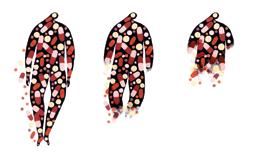
Send letters to readersletters@readersdigest.co.uk
NOVEMBER 2019 • 9 HEALTH • MONEY • TRAVEL RECIPES • FASHION • TECHNOLOGY READER’S DIGEST SMALL AND PERFECTLY INFORMED SEPTEMBER 2019 Ziggy Marley 14 Musings On Fear, Fame And His Father The Building Blocks To Mental Health? LEGO Forever Young INSIDETHERACETO CUREMORTALITY CULTURE
Include your full name, address, email and daytime phone number. We may edit letters and use them in all print and electronic media. WE WANT TO HEAR FROM YOU!
LIBRARY LOVIN’
After reading the library article by Anna Walker, I’ve been eager to visit the libraries mentioned and was most taken by the Women’s Library in Glasgow.
Being a woman with a keen interest in female empowerment, I can’t wait to visit this place and signpost to local residents who have no exposure or knowledge of this library.
I was first introduced to Reader’s Digest through my father back in Sri Lanka, who encouraged me to read articles to practise my English, and grow my knowledge and vocabulary.
I’ve since been working with an organisation called Abuse Never Becomes Us (ANBU), a UK registered charity focusing on supporting and empowering adult survivors of child abuse in the Sri Lankan Tamil community. A taboo subject that is still hardly ever discussed.
From this experience I understand the need that many women have to find guidance and support on these issues. I hope this library will contain information that will build knowledge and empower women to be independent.
Libraries are a treasure, the new trend of d igitisation doesn’t have the same touch and feel as a printed book.
ARATHI
RAJANTH, Sutton

KNEES UP
While reading your article “New Hope for Ageing Knees” I was struck by memories of my grandfather. He suffered from knee and ankle pain for many years. He was lucky enough to have both knees replaced but unfortunately only one of which was considered successful.
I have many friends and family who are experiencing similar problems and I wanted to spread a little of my own learning on the subject. Ginger syrup is a simple yet surprisingly effective way to help with joint pain. I now supply it on a regular basis to them and while it doesn’t help everyone, there are some who swear by its antiinflammatory properties.
Simply boil grated ginger root and some dark brown sugar for five-six minutes and allow to cool. Drink a spoonful or two in hot water every day and after a few weeks you should start to feel the benefit. It is also a home treatment for joint pain brought on by arthritis.
I wanted to thank you for another informative article and hopefully spread a little help in the process.
SCOTT SMYTH, Londonderry
OVER TO YOU
10 • NOVEMBER





100s
Thousands




OF CUSTOMERS HAVE ALREADY CHOSEN ROOFSURE: 30-YEAR manufacturers guarantee + 10-YEAR insurance-backed guarantee We have the Government’s TRUST MARK for“Good trading practices, good customer service and technical competence” We never use subcontractors, only our EXPERTLY TRAINED sta For 30 YEARS a family run business The UK’s NO.1 foam insulation company Our unique spray-on foam insulates, waterproofs, bonds and lines your roof Will reduce heat loss by up to 58% - SAVE MONEY! The whole process takes just 1-2 days to completeQUICK, EASY, CLEAN Can be applied to roofs with or without felt Stops slipping slates, tiles and leaks, eliminating the need for future external roo ng maintenance 10 9 6












FREEPHONE:
999 4880 OVER 60? YOU MAY BE ELIGIBLE FOR FINANCIAL
A
AS SEEN ON GRAND DESIGNS 2017 “WINTER ROOF MOT” FREE NO OBLIGATION SURVEY GUARANTEE REDUCE HEAT LOSS BY UP TO 58% PROBLEMS
INNOVATIVE
30
POOR
WINTER. SAVE 25% REASONS
CLOSED CELL FIRE RETARDANT FOAM
0800
ASSISTANCE OR
SUBSIDY PAYMENT
CAN BE SOLVED IN 1 TO 2 DAYS WITH THIS
ENERGY-SAVING SOLUTION. LEAVES YOUR ROOF MAINTENANCE FREE FOR
YEARS GUARANTEED.
LOFT INSULATION? MISSING ROOF TILES, LEAKS? CREATE A WARM AND SECURE ROOF THIS
WHY
of
1 2 3 4 5 7 8
CLASS 1

12
Photo: ( t his Page)
© h P bfotos/ a lamy s tock
Photo

The World TURN THE PAGE…
See
Photo: (Next Page)
© iN igo b ujedo a guirre-V ie W/ a lamy s tock Photo

…differently
If they look up at the ceiling, visitors to Rotterdam’s Market Hall can marvel at an 118,000 square foot image projected onto its ceiling. Artists Arno Coenen and Iris Roskam employed a computer programme used for making animation films in Hollywood to create giant fruits and ears of wheat as big as cranes. Even if you can tear your gaze from the spectacular ceiling, you won’t be disappointed as the foodie’s heaven has dozens of stalls; offering traditionally made cheese, exotic fruits, spices from all over the world and just about anything else in between.

Cat Fight!
The claws are well and truly out in the Mann residence, as Olly's beloved cat, Coco, fails to adapt to her new compadre
My cats hate each other. It’s taken me six months to admit it, but there you go. Two living beings, under my roof and part of my family, detest each other and—I suspect, because I do not speak Cat—spend much of the day plotting each other’s demise.
It was not supposed to be this way. As I have previously documented in these pages, we spent a long time, and much mental effort, researching the best possible feline companion for our elderly tabby, Coco, in order to line up her successor without causing her too much concern. We were told, by numerous re-homing centres and online forums, that the

Olly Mann presents Four Thought for BBC Radio 4, and the award-winning podcasts The Modern Mann and Answer Me This!
most congenial colleague our older female cat could have was a newborn male kitten—and that, with a bit of luck, she might be persuaded to "mother" him.
We waited months until an appropriate cat came on the scene. My wife works as an assistant veterinary nurse, so she put feelers out in the feline fraternity that we could provide a good home for a cat with the necessary stats. One day, we had a call from the "Kitten Man of Waltham Abbey"—I didn’t ask questions, this is how he was introduced—who said a sparky, affectionate three week-old had come into his possession. He sent us a photo: the cutest creature I had ever seen. Bright-eyed. Thick, wild coat. Head cocked; a pose that suggested curiosity, character and charm.
The Kitten Man said we had to confirm our intention to adopt within three days. So, our weekend was spent debating the pros and
illustrations
by
Daniel Mitchell
IT’S A MANN’S WORLD
16 • NOVEMBER 2019

cons. We’d been waiting for an appropriate candidate for so long, we wondered if now was actually the right time; my wife was six months pregnant, so we had a tight three months to get this cat toilet-trained, neutered and acclimatised to our house rules. Did we really want to endure high summer with the smell of cat litter flowing through the house, unable to even open a window? But then we’d revert back to that photo. Those eyes! Those cheeky, comely eyes!
Alvin, as we named him, entered our lives three weeks later. My
office was designated as the nursery slope until (slowly, slowly) he was introduced to the rest of the house. At the time, it seemed stressful, tending to a young animal in such a confined space. And the odour of wee was seriously affecting my ability to work from home. But looking back, that period feels like the halcyon days of peacetime.
We’d done a bit of scent-swapping —putting Alvin’s fur inside Coco’s basket, for example—in an attempt to prepare her that a visitor had arrived. But she was so secure, so complacent, so old, frankly, that she didn’t seem to notice. One evening, when Alvin was ten weeks old, we brought them both into the sitting room, my wife and I each holding one cat in our laps, so they could check each other out.

Suddenly, Coco—normally so placid, so unmotivated—unleashed a sound I had never heard before. It wasn’t quite the same quivering howl she targets at garden intruders. It was more guttural, more… unnatural. Presumably it was intended to make Alvin hide, or seek solace in another room, or, preferably, street. Instead, he responded with a swift paw to her neck, then sprinted up the curtain. Coco hissed, and jumped, and hissed again. And then threw up on the So much for that supposed mothering instinct.
IT’S A MANN’S WORLD
For weeks afterwards, we gradually reintroduced the two cats to each other; each time, a slightly more sedate version of the same events transpired. We were hopeful that, certainly by the time my new son Toby arrived, the cats would at least have learned to tolerate each other. But no. Six months on, they still fight each morning, when the door that separates their two territories is opened. On the rare occasion they both join us on the sofa, we fashion a wall of blankets and cushions between them, to deescalate hostilities.
unremarkable feature of our daily soundtrack. I feel guilty, because I forced this situation on Coco, in her dotage. But, what can I say? Alvin remains super-cute. Those eyes!
“COCO, NORMALLY SO PLACID, SO UNMOTIVATED, RELEASED A SOUND I HAD NEVER HEARD BEFORE"
However hard we try to keep them apart, pet them equally and feed them simultaneously, each day brings at least three fights. Howling, spitting and puking are now an
Oddly, when we’re out of the house— I rigged up a CCTV camera to confirm this—the two cats can co-exist for seven hours without conflict.
So some of their rivalry is evidently performed for our benefit, perhaps to demonstrate their place in our family pecking order. I wish I could tell them we’d much rather they just left each other alone. Our property is large enough for them to do just that.
At least one thing has become clear. When Coco does finally shuffle off this mortal coil, I doubt we’ll be giving The Kitten Man a call. n
Beetle Mania
Not only can cockroaches survive for a week post decapitation, but their heads can also continue operating independently, with their antennae moving back and forth for several hours. Cockroaches are able to survive this extreme injury for so long because they breathe through tiny holes covering their body segments, rather than through their mouth. The roach will only eventually die from decapitation because it cannot eat, or drink water. Their impressive circulatory system also means that they can hold their breath for 40 minutes, and survive being submerged in water for half an hour.
SOURCE: PESTWORLD.ORG
NOVEMBER 2019 • 19 READER’S DIGEST

20 ENTERTAINMENT
photograph by by Sarah Dunn/Contour/Getty Images
Sir Ian McKellen:
“Life Would Be Boring Without Laughter”
by Jessica Summers
National treasure, and the foremost actor of his generation, Sir Ian McKellen reflects on pride, humour and the power of ageing
Being in a room with Sir Ian McKellen is as captivating as one would imagine. He takes a seat, elegantly crosses his legs and waits, his piercing blue eyes conjuring an amused expression that lights up his whole face. It’s a look his many fans will be familiar with through watching his extensive film work, (Lord Of The Rings, X-Men, Gods and Monsters) and select few will have seen up close on the stage. In his most recent film, The Good Liar, his character is both an amalgamation of previous parts he’s played and simultaneously unlike any role he’s taken before. The protagonist, Roy Courtenay,
an aged con artist willing to exploit anyone housing a hefty pile of cash, exudes a cheery exterior while harbouring an odious temperament that bolts from his body unto those unfortunate enough to get in his way. The untrained fan might assume that such a hideous personality would be a challenge for such an illustrious and well-mannered actor to play, but quite the opposite is true. The reason McKellen can switch into a snarling menace on screen is that he finds it all rather fun.
“I suppose the trick of acting is to meld the character that you’re playing with the character that you’re playing in real life, ‘All the world being a stage’ as Shakespeare
NOVEMBER 2019 • 21
“THE WORK I’VE DONE FOR GAY RIGHTS IN THIS COUNTRY IS NO MORE THAN WHAT ANYBODY WHO CARED DID”
said. So it’s a question of using your imagination, which children have in abundance, but most adults seem to lose, although many actors are kids at heart. As for playing someone who does dreadful things, well in one’s imagination…” he chuckles in spite of himself. “You don’t—of course—have to actually kill someone yourself to be convincing as a murderer, it’s all imagination and a mixture of oneself and the character.”
This indelible focus on imagination is undoubtedly the very thing that makes McKellen’s work so delicious. The thrill he clearly gains from immersing himself in curious worlds, journeys into our brains like a fish caught in a current and swims there long after the story is done. Indeed, the experience as one of his audience members is such that you don’t feel as if you’re watching a performance at all. It’s rather more similar to reading a book—with each

INTERVIEW: SIR IAN MCKELLEN 22 • NOVEMBER 2019

NOVEMBER 2019 • 23
Starring alongside his longtime friend Helen Mirren in The Good Liar LANDMARK MEDIA / ALAMY STOCK PHOTO

participant taking a different focus and letting their own imaginations escape them.
Despite having such a profound effect on the cinephiles and theatregoers of the world, McKellen is unblinkingly humble. A— nowadays rare—quality that seeps into much of our conversation while discussing his amazing life achievements thus far. A founding member of Stonewall, a UK gay rights charity, which fought to repeal Section 28 (a homophobic clause that prohibited the teaching or promotion of homosexuality) in the Eighties, McKellen sees himself as merely a vessel of hope rather than a front-runner of change.
“I don’t feel a need to be a leader in
any sense, in any situation. I’m more of a follower really. The work I’ve done for gay rights in this country is no more than what anybody who cared did, or is doing now. I joined the team, joined the club, joined the crowd and because I work in the public eye it seems perhaps that I do more than I actually have done, but I’ve met some wonderful people whose contribution to changing the world was much bigger than mine. People who understand the law and how politics works and how to manoeuvre things, people like Angela Mason and Peter Tatchell. They’ve been inspiring.”
However modestly McKellen would see himself, since boldly coming out during a BBC Radio 3 broadcast
24 • NOVEMBER 2019 GUY BELL / ALAMY STOCK PHOTO
in 1988 the majority of us see it differently. Including his long-time chum Simon Callow, who touched on his own coming out experience during an interview in our December issue: “As I always say to Ian, I was the John the Baptist to his Jesus. I paved the way and when he came out, he was a natural leader.”
Amid all the drama and violence of The Good Liar, one particularly edifying aspect is the strength and boldness portrayed by a predominantly senior cast. Often overlooked in Hollywood, dismissed as secondary characters or cast in stereotypically frail roles, it’s quite something to watch mature performers manipulating each other, fighting each other and out-witting each other in a way that’s seldom depicted. No broken bones or vulnerability in sight.
“Older actors have always had power,” McKellen says with gusto, “there’s a wisdom you can bring to a role that you don’t automatically have during your younger years. But also, just because you’re older doesn’t make you a shell of what you once were, it doesn’t hinder you and senior actors are adept just as senior people are in all walks of life. The idea that you suddenly fall short of being artistic or become less human when you’re elderly is so silly. You just can’t run as fast!”
And, for anyone who still doubts that sentiment, just wait for the truly
“THE IDEA THAT YOU SUDDENLY FALL SHORT OF BEING ARTISTIC WHEN YOU’RE ELDERLY IS SO SILLY”
shocking-yet-brilliant scene in which Sir Ian McKellen and Dame Helen Mirren go hell-for-leather in a good old-fashioned bust-up, which, no doubt, their youthful sensibilities helped with.
“[Our chemistry] is not something we’ve worked at,” says McKellen, “this is the first film we’ve done together but we’re friends and she’s such a professional. You don’t have to get on with the actors you’re working with but my goodness does it help. She’s got a great sense of humour and works very hard and that fits in with my discipline too.”
For an actor who has had varying career-defining roles it’s almost a wonder that McKellen isn’t repeatedly held to account for specific parts he’s taken in the past. So often performers who play magnificent characters are forever defined by—and bound to—that role. So much so that any future
NOVEMBER 2019 • 25 READER’S DIGEST
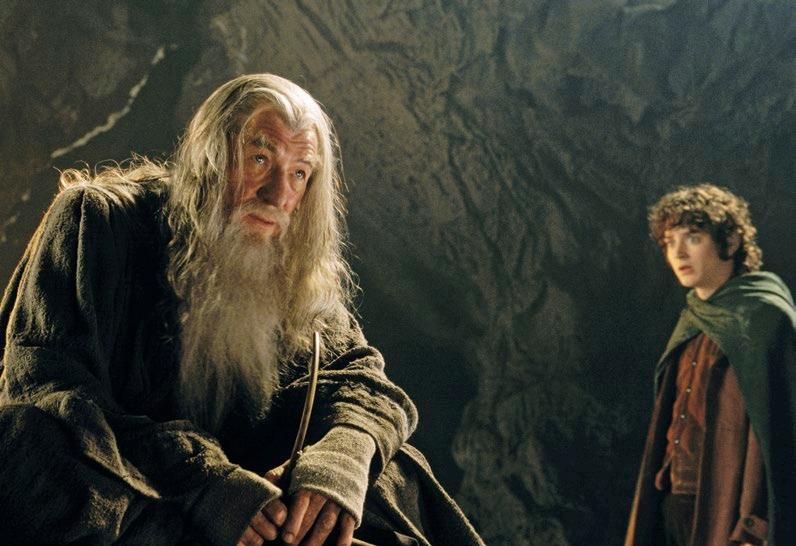
endeavours are tainted with their past, making suspending your disbelief quite a challenge.
McKellen though, has a magical sincerity while on-stage or on-screen, a way of never letting you forget the current character and always making the audience lose themselves in the story.

Gandalf. I’ve loved and related to the characters I’ve played, otherwise I wouldn’t have played them, but trying new adventures is such fun.”
In a related stream of thought
“I’ve been offered similar jobs before, but it doesn’t always benefit me or an audience if I take them—that way you could turn into a caricature.”
McKellen imparts, “I’ve played some marvellous roles, like Magneto and
McKellen offers the opinion that comedy roles are not to be sniffed at and form an incredibly significant part of the acting domain. Ever one for the arts, snobbery, evidentially, isn’t a trait he bothers with in the
PICTORIAL PRESS LTD / ALAMY STOCK PHOTO / ITV/SHUTTERSTOCK 26 • NOVEMBER 2019
Starring as Gandalf in the Lord of the Rings franchise. (Below); as Mel Hutchwright in Coronation Street
world of theatre.
“Oh how boring life would be without any laughter!” McKellen exclaims with a grin. He played Widow Twankey in the Old Vic’s Panto and acted in Coronation Street as the playwright, Mel Hutchwright. “They were special parts of my career that I was thrilled to be involved in.”
But, after such a long list of accolades, where does a mogul such as McKellen go next?
“I still harbour the dream that I might one day be in an on-stage musical. It would be lovely wouldn’t it? To step out and sing a song, but I can’t sing so that’s just a dream…” Here McKellen bursts into song, bellowing the line, “I had a dream”, with unspoiled pitch and a giggle.
As much as fans may want to pinpoint the peculiar, lovable quality that makes McKellen so mesmeric, he’s faintly untouchable to those who don’t know him. But, watch him in his element and you’ll understand. This grandiose man, so eloquently spoken and impeccably dressed
“I STILL HARBOUR THE DREAM THAT I MIGHT ONE DAY BE IN AN ON-STAGE MUSICAL. IT WOULD BE LOVELY, WOULDN’T IT, TO STEP OUT AND SING A SONG?”
is a servant to his craft, and that’s where you’ll find the glimmer of his soul. So dedicated is he to his art that he morphs seamlessly between one character and the next, never over-exerted, always under control. And, as he whips his scarf over his shoulder, hops on the back of a motorbike, and whizzes off past Embankment, it’s clear he’s wonderfully unstoppable. n
The Good Liar is in cinemas across the UK from 8 November
Crazy, Stupid Love
In 19th century Austria, women danced with a slice of apple under their armpit. They would then offer the slice to whichever man they fancied the most.
In the 1600s, Puritan courters would carry a hollow tube with them on dates, through which both lovers could speak without the threat of being overheard.
In the 17th century, Welsh bachelors would present their love interest with a special spoon, as a symbol of their devotion.
SOURCE: DATINGNEWS.COM
NOVEMBER 2019 • 27
READER’S DIGEST




















Expert team reports that consumers are paying different prices for the same stairlift
LATEST STAIRLIFT REPORT warns consumers of up to 50% price swings + reveals where REAL savings are!
A RECENT market survey has created alarm over the different prices being offered to the public for stairlifts. In order to ensure members of the public are not being mislead, a consumer watchdog group has commissioned an in-depth report into the UK stairlift market. PROTECTING THE PUBLIC ADVICE YOU CAN TRUST ESSENTIAL READING DO NOT OVERPAY EVERYTHING IS COVERED FROM:-
● What type and model?
● Where to buy?
● What to expect?
● The key questions
● Customer service
● Reconditioned models
● Rental options
● The costs
● How stairlifts work
● Safety features
● Optional extras
● Discounts
For your FREE Guide –FREEPHONE Lines Open 8am-8pm Mon-Fri 10am-4pm Sat-Sun
0800 074 3961
or visit: www.mobinfo.co.uk QUOTE S398PC
● Price comparison chart Stairlift experts expose truth to public about stairlift prices!






































































































































FREE GUIDE tells you all you need to know! The information we will send you will be from our authorised stairlift practice for your area. Your information will only be used to deliver our service and as set out in our Privacy Policy: www.mobinfo.co.uk Return this coupon today for your FREE GUIDE Please send me my FREE Stairlift Prices Compared Guide D D M M Y Y Mobility Aids Information Service (S398PC) FREEPOST LON15651, London SE1 1BS WAS £4.99 * MR/MRS/MISS/MS * ADDRESS * POSTCODE * TEL NO. (In case we need to confirm address) * D.O.B. TO ENSURE CORRECT DELIVERY WITHOUT DELAY, PLEASE COMPLETE ALL SECTIONS MARKED * IN BLOCK CAPITALS PLEASE. FREE GUIDE tells you all you need to know! The information we will send you will be from our authorised stairlift practice for your area. Your information will only be used to deliver our service and as set out in our Privacy Policy: www.mobinfo.co.uk Return this coupon today for your FREE GUIDE Please send me my FREE Stairlift Prices Compared Guide D D M M Y Y Mobility Aids Information Service (S398PC) FREEPOST LON15651, London SE1 1BS WAS £4.99 * MR/MRS/MISS/MS * ADDRESS * POSTCODE * TEL NO. (In case we need to confirm address) * D.O.B. TO ENSURE CORRECT DELIVERY WITHOUT DELAY, PLEASE COMPLETE ALL SECTIONS MARKED * IN BLOCK CAPITALS PLEASE.

Glenn Tilbrook

I REMEMBER…
Glenn Tilbrook, 62, is the lead singer and guitarist of the English band Squeeze. He looks back on his childhood in London, early passion for music and the beginning of Squeeze
…BEING ABOUT THREE OR FOUR AND LOOKING THROUGH MY MUM AND DAD’S LP COLLECTION, which was in the corner of our sitting room. I particularly remember a Lena Horne live record but, more than the sound of her [voice], I remember the smell of the record. There was music playing around the house and my earliest memory is of music generally.
… GROWING UP IN BLACKHEATH STANDARD IN SOUTH EAST LONDON. I still live near there. I was
brought up in a council flat, as my parents separated. My mum, Mandy, had the council flat from 1954 until she died in 1997. It was security for her. I had an older brother who sadly died when he was 33. I’m sure I was an annoying little brother but we shared a bedroom until he left home at 16, so when I was 11 I had the room to myself.
…LOOKING BACK I REALISE THAT I WAS THE RECIPIENT OF A REALLY GOOD TIME IN THE
ENTERTAINMENT
30 • NOVEMBER 2019

31



I REMEMBER… 32 • NOVEMBER 2019 ANL/SHUTTERSTOCK
HISTORY OF THE WELFARE STATE. We had the NHS, good hospitals and good housing that was maintained by the council. I think all the families in the flat where we grew up—there were six families per block—had been housed at the same time and they were all roughly the same age, so there were a lot of other kids around.
…OUR FLATS WERE BUILT ON AN OLD BOMBSITE. The bottom of our road was entirely filled with rubble and there were several bombsites around us. It now seems incredible to me now, but at that point it was entirely natural. I must admit, they were dangerous places but if you were a kid it was lots of fun. It was the early Sixties, 20 years after the war, and they were still clearing up.
…I WAS QUITE A SHY LITTLE BOY, NOT VERY CONFIDENT, WHICH HAD ITS UPS AND DOWNS. I had a group of friends who I used to get on with really well. From the age of six or seven though, I was really happy to spend time alone, and the thing that I liked doing most was playing piano. I also used to borrow my brother’s guitar. I was very lucky that a friend of the family taught me how to tune it and after that I taught myself to play. I absolutely loved it.
…IT WAS NEVER A CHORE LEARNING HOW TO PLAY MUSIC. I was seven when I started and I think
that by the time I was 11, I was pretty proficient on the guitar. There were lots of things that I did wrong in my piano playing—an 11-year-old doesn’t have that level of expertise— but that didn’t stop me from finding it fascinating and often, my musical ineptitude and curiosity has led me to places that I don’t think I would necessarily have got to any other way.


(Top) Glenn with his mum, Mandy; (Bottom) An early Squeeze concert
READER’S DIGEST
NOVEMBER 2019 • 33
Squeeze with Jools Holland, 1980; (Bottom) Glenn with Chris Difford


…AT SECONDARY SCHOOL THERE WAS A VERY HELPFUL TEACHER who was encouraging to me. They obviously saw that I loved music, but by the time I got round to taking piano lessons I had a different teacher who was very old school. He wanted me to play the piano correctly and, of course, I had taught myself, so they didn’t sit very well together.
…THE ACADEMIC SIDE OF SCHOOL WASN’T MY CUP OF TEA, THOUGH I ALWAYS LOVED READING. We didn’t have books in the house, but I joined the library and did a lot of reading when I was growing up. At junior school, I read all the Just William books and although they were written in the 1930s, the life of a boy then didn’t seem so terribly different to my own.
…MY MUM WAS A TYPIST AT COUNTY HALL. It was a relatively stable job and she stayed there until she retired. I didn’t have much contact with my father, Peter. He wasn’t very interested in me when I was growing up but that started to change when I was 13—he bought me an electric guitar and an amp. That was fantastic. I remember him giving me a very stern talk when I was 16, about music not being a very wise choice, but by that time he’d lost me. I was going to do what I was going to do.
I REMEMBER… 34 • NOVEMBER 2019
SHUTTERSTOCK
…HAVING A CAREER IN MUSIC WAS VERY CLEAR TO ME AS A CHILD. I was very determined and failure was never an option, which in retrospect is extremely lucky. It took me a long time to realise—and I don’t mean this in a conceited way—that what I have, actually, is a gift. It is just innate in me and I did everything I could to follow it because that was what I wanted. I didn’t have many other distractions, so I was able to give it all my time. Music was all I ever wanted to do.
…BEING EXPELLED FROM ELTHAM GREEN SCHOOL. The film, Clockwise, starring John Cleese, was based on the headmaster who was brought to my school when I was in first year. It was a bit of a wayward school and he imposed military-style discipline. If you were a second late you would be put in detention and made to stand in a square on the concourse. He walked around with a cane and mortarboard and he would come and stare at you, about half an inch away from your face.
He was really a very strange man. He brought in a rule that said you couldn’t have hair below collar-length and obviously, I had that. In the end, he expelled me—not before caning me twice. It hurts, I can tell you, and I am still really puzzled by his sadistic level of enjoyment. He did the full performance of walking the length of the room and having a run up.
…MY SECOND SECONDARY SCHOOL WAS FANTASTIC. I left school at 15 and I had a succession of mostly shop-based jobs. My last proper job was working in a musical instrument shop called Bill Lewington in Cambridge Circus, London.
…MEETING JOOLS HOLLAND WHEN I WAS 14 AND THEN INDEPENDENTLY OF JOOLS, MEETING CHRIS DIFFORD. They were separate friends but then Chris and I formed a band. We had a different pianist, drummer and bass player for a while, then Jools joined us in an early version of Squeeze. When I was 17, we started getting more gigs outside of our local area and were playing across London. Then we started getting support around the country. So, in a quiet way and over a few years, music was taking up more and more of our time.
…ALWAYS THINKING WE WERE GOING TO SUCCEED. I never had any doubt that we would. In retrospect, I’m surprised at my attitude, because I didn’t have any fear of failure—failing wouldn’t have been an option, anyway.
…WE MET MILES COPELAND III AND HE SIGNED US. He got us small gigs and then we put out an EP, Packet of Three. Chris and I had been together for four years—at that age it
NOVEMBER 2019 • 35 READER’S DIGEST
felt like quite a long time but we didn’t waste our time—we were writing and were very prolific. So, by the time we started gigging around, we were a really good band, we were musically proficient—more so than most of our contemporaries. And, by the time we got a record out we were actually streets ahead of most other bands, I think.
…JOOLS HAD A LIFELONG LOVE OF BOOGIE-WOOGIE ROCK AND ROLL and I hadn’t dealt with that as much, and Chris liked The Velvet Underground. I absolutely adored pop and guitar music like Jimi Hendrix and Wes Montgomery, so we all brought something different to the table and the sound we made was uniquely “us.” It wasn’t by design; it was the accident of us being a group.
…FROM THE TIME I WAS 22 TO WHEN I WAS 25, WE WENT FROM PLAYING PUBS TO PLAYING AT
MADISON SQUARE GARDENS AND that was an incredible trajectory to experience at that age. The thing you don’t notice is that you give up a certain part of yourself to do that. There is always some sort of price to pay for how you develop. But I still think it’s a small price to pay for the reward of doing what you want to do.
With your contemporaries and some school friends, it’s hard to relate what your life is like, doing what you do, and the opportunities you have. I’m never far from realising it’s not normal.
…DEALING WITH MY OLDER BROTHER WAS HARD FOR OUR FAMILY, because he didn’t have a successful life and he was never very happy.
I was always aware of that—we talked about it openly and I tried to help him. It really did seem like he had turned a corner at one point— but he died of a drug overdose.

I REMEMBER…
…WATCHING A BBC SCOTLAND DOCUMENTARY ON THE IMPLEMENTATION OF UNIVERSAL CREDIT. Scotland was the first place where it was rolled out. It was apparent then that it wasn’t a very efficient system and that it threw people who were already struggling into deeper poverty.
Within this programme, there was one particular single-parent household—a mother and her son who had lived in London and were struggling to live there and ended up being advised that the best place to move to was somewhere in Scotland. So the mother went up there with her 12-year-old son, no family support, having to put food on the table. Bits of that, of course, resonated with me—my mum struggled at some points.
…THE HUMAN ASPECT OF UNIVERSAL CREDIT [MADE ME] think,What can I do to really help
people like that? The best thing I could do was to use whatever limited position I have to try and encourage people to donate to food banks. So I did a solo gig and was amazed at people’s response. People really wanted to help, they can be really generous—that was a lovely thing to rediscover.
I spoke to Chris about it and he was very much on board with the idea of doing the same with Squeeze and, of course, with Squeeze it becomes a much bigger thing because we are playing bigger venues for thousands of people. It’s taking a step up and it feels great to contribute to something greater than ourselves. People want to help and that is so humbling. n
As told to Joy Persaud
The Difford And Tilbrook Songbook 2019 tour will benefit the foodbank charity The Trussell Trust. Tickets are available from gigsandtours.com

READER’S DIGEST

Teach Your BRAIN New Tricks
By Eric Haseltine
Exercising these three talents is a good reminder that, even on a bad day, your built-in computer is awfully powerful
1Move Things With Your Mind
Tie a two-or-three-foot piece of string through the handle of a mug and dangle it in front of you, keeping it as still as you can. Then, using only your mind, will the cup to sway back and forth. After 20 to 30 seconds, you will see the cup start to move. Then, again using only your mind, order the
cup to stop. Repeat, this time willing the cup to sway like a pendulum.
No, you can’t literally move things with your mind. But this experiment—which feels eerily like telekinesis—proves that your unconscious exerts extraordinary control over your muscles, causing them to contract in subtle ways that
HEALTH 38 • NOVEMBER 2019
produce tiny but precise motions that move the cup. Although you probably weren’t aware of which muscles you contracted to cause the cup to sway, your body knew what to do through a process called “implicit memory”, in which your brain files away enormous amounts of information unconsciously, such as which muscle groups will cause which kinds of subtle motions.
2
Navigate in the Dark
Bats navigate in the dark by listening for the returning sound they create from ultrasonic clicks, chirps, and tones. We all have an inner bat that can also echolocate. Find a long stick with a hard tip (metal is ideal) and a friend to spot you, then go to an uncarpeted area of your house. Close your eyes and tap the stick in front of you, as blind people do. Observe that you can get a sense of the presence of large nearby objects, just by listening to the clicks.
If you’re like most sighted people who do this for the first time, you’ll just “know” when you’re getting close to a wall or a large object without knowing exactly how you know. This “knowing without knowing how” is another example of implicit memory.
But if you listen carefully to the clicks of your stick, you’ll start to notice that a click made from tapping the floor a few feet from a wall has a hollow quality because of slight
echoes that immediately follow the original click of contact.
If you tap the stick closer to the wall (within a few inches), the click will have a somewhat higher pitch. Some people report that clicks right next to the wall sound “deader” because they contain fewer echoes and overtones.
3
See Behind You
Sound shadowing is a close cousin of echolocation. It lets you sense when someone—or a large something, such as a predator—is right behind you, even when that someone (or something) makes no sound.
Stand with your eyes closed on a carpeted surface and have a friend sneak up behind you so that you don’t hear their footsteps, breathing, or clothes rustling. The experiment works best when you have a conspicuous sound source, such as a radio, located about ten feet behind you to create background noise.
As your friend approaches from behind, even though you can’t see or hear them directly, you should be able to “feel” the person’s proximity by the sound shadow that he or she casts—the way the person blocks the sound. If you pay close attention to the sound shadow, you’ll perceive it has two parts: a slight lowering of volume and a deadening of echoes of the radio noise off surfaces behind you. n
© 2018 by e ric h aselT ine NOVEMBER 2019 • 39
PsychologyToday.com (June 2018),

HEALTH 40
The increasing resistance of bacteria to antibiotics is a major public health threat. We all have a share in the fight to overcome it
LET’S KEEP ANTIBIOTICS WORKING
By Susannah Hickling


“A
box of amoxicillin, please,” I asked the shop assistant. I’d had a tip-off you could buy antibiotics without a prescription in this grocery store serving the Polish community in a market town in the rural west of England.
Sure enough, no questions asked, the store employee reached into a glass cabinet next to the checkout and pulled out a packet of penicillin from a variety of drugs on display. I paid £15.29, thanked her and left with 24 tablets. Neither she nor I had any idea whether they were the appropriate treatment. It is illegal in all EU countries—the UK and Poland included—to dispense antibiotics without a prescription from a medical professional. But my purchase wasn’t just against the law, it was also contributing to what Dominique Monnet of the European Centre for Disease Prevention and Control (ECDC) calls “a major public health threat”—the increasing resistance of bacteria to antibiotics.
The discovery of penicillin 90 years ago revolutionised medicine. “Before antibiotics, thousands died from bacterial diseases, such as pneumonia, or infection following surgery,” explains Monnet, who is head of the ECDC’s disease programme on antibiotic resistance. Antibiotics now prevent
women dying after childbirth, preterm babies succumbing to bugs they’re too weak to fight off and elderly people perishing from urinary tract infections. They zap bacteria responsible for infections ranging from acne to tuberculosis and are used to treat and prevent illness in livestock as well as humans.
But these miracle drugs are losing their power because of overuse and misuse. As a result, we're in danger of entering what the World Health Organisation (WHO) has called “a post-antibiotic era in which common infections and minor injuries can once again kill.” In this scenario, Monnet says, “organ transplants,

"ANTIBIOTIC RESISTANCE IS NOT A FUTURE THREAT. IT IS CAUSING MANY DEATHS NOW"
cancer chemotherapy, intensive care, and other medical procedures would no longer be possible. Bacterial diseases would spread and could no longer be treated.” As a result, 10 million people a year could die worldwide by 2050, according to a 2016 report funded by the Wellcome Trust and the UK government.
42 • NOVEMBER 2019 LET'S KEEP ANTIBIOTICS WORKING
“Antibiotic resistance is not a future threat,” points out Andreas Sandgren, deputy head of ReAct Europe, an independent organisation that urges action on antibiotic resistance. “It is profoundly affecting us and causing many deaths now.” The ECDC estimates that 33,000 people die every year in Europe as a direct result of an antibiotic-resistant infection, costing 1 billion euros annually.
“We need to protect antibiotics by reducing exposure to them and develop new agents to replace the ones we’ve got,“ says Dr Nicholas Brown, a medical microbiologist at Cambridge University Hospital in the UK and head of Antibiotic Action.
So how did we get here? “Resistance is inevitable and is a natural phenomenon that has always occurred following exposure to antibiotics,” says Dr Brown. “The more we use antibiotics, the more resistance will emerge and the less effective they become.”
Resistance means that doctors have to use ever more potent antibiotics to combat some infections. Some lastline antibiotics—treatments of last resort—are beginning to fail. Bacteria that are now resistant to many antibiotics include those that cause pneumonia, meningitis, urinary tract infections (UTIs), gonorrhea, surgical site infections like MRSA, diarrhea, bloodstream infections such as sepsis, malaria, skin infections including impetigo, and TB.

Bacteria, rather than people, become resistant to antibiotics. The germs mutate in response to these medicines, with the strongest capable of surviving. This is more likely to happen if the treatment is unnecessary, too short or too long, at too weak a dose, or not targeted at a specific bug.
New antibiotics aren’t being developed fast enough to keep pace with resistance. “A lot of big pharmaceutical companies have withdrawn from antibiotic development, because it is high risk,” explains Dr Brown. “It costs between £400–800 million to take a drug to market and get regulatory approval for it to be used. The fallout rate is high—only about one in 25 drugs actually make it to market. In that situation the drug companies never get any reimbursement for the money they put in.”
Promising new antibiotics in the pipeline include the soil-derived teixobactin and cefiderocol. But in 2017 the WHO warned that only eight of the 51 therapies in development to treat antibiotic-resistant pathogens were innovative treatments that could add value to existing drugs.
NOVEMBER 2019 • 43 READER’S DIGEST
“There is a large variation in the level of consumption of antibiotics among European countries,” says ReAct’s Andreas Sandgren. According to the ECDC, people in Cyprus, Spain, France, Romania, and Poland are the biggest
AN EU REPORT FOUND THAT SEVEN PER CENT OF ANTIBIOTICS WERE TAKEN WITHOUT PRESCRIPTION
viruses, according to a Eurobarometer survey from the European Union.

consumers. Meanwhile, the Dutch, Estonians, and Swedes use them very little. In the Netherlands and Sweden, there's a continuing downward trend, with Finland, Germany, Italy, Luxembourg, Norway and the UK also showing decreasing use.
At least 80 per cent of antibiotics are prescribed in the community, mostly by family doctors. But people can also get them on the internet, directly from pharmacies, and even—as I found—in other shops. Sometimes people pass unused tablets to friends or family members. A 2017 EU report found that seven per cent of antibiotics were taken without prescription. One in five Europeans took antibiotics for colds or flu in 2018, even though antibiotics don’t kill
Spain is now having to tackle high rates of antibiotic consumption and—as a result—antibiotic-resistant infections. Its residents take three times as many antibiotics as people in the Netherlands, which has the lowest rate of antibiolic consumption in Europe. Much research has been devoted to investigating the extent of the problem. Results have varied from an eye-popping 64 per cent of pharmacists admitting to dispensing antibiotics without a prescription in a 2014 survey in northern Spain to 19 per cent in a 2017 study in northwestern Spain.
But the tide could be turning, thanks to the Spanish government’s determination to address what it has described as “excessive and frequently inappropriate” antibiotic use. “The demand for over-the-counter antibiotics is a situation that we experience every day in pharmacies, although in the last two years I have appreciated a fundamental difference,” says Virtudes Roig, a pharmacist from Valencia. “The patient is aware of the legislation and when refused does not insist, which means that the information campaigns have worked.”
One country that has long embraced good antibiotic stewardship is Sweden. The rapid spread of penicillin-resistant ear infections among children in the
44 • NOVEMBER 2019 LET'S KEEP ANTIBIOTICS WORKING
Today, local multi-professional groups work with GPs, while the government funds a national executive group. There is rigorous monitoring both of antibiotic prescribing and resistance, and a national target of no more than 250 prescriptions a year per 1,000 inhabitants.
upper respiratory tract infection will go of its own accord.
It has worked. Outpatient antibiotic prescriptions dropped 43 per cent over 24 years, 73 per cent among children. There has also been a shift away from broad spectrum to narrow spectrum antibiotics, which target specific bugs and reduce the development of resistance. At the same time, levels of resistant bacteria—always low—have remained stable.

Keeping prescribers up to date is crucial. “There are constantly new studies being done and today we know that there are few, relatively small sub-groups of respiratory tract infections that fare better with antibiotics than without,” says Lars Blad, chairman of the Strama Network and WHO consultant on containing antibiotic resistance. “These studies are continuously taken into modern and updated treatment guidelines.”
Now doctors can often advise patients to wait two to three days to see if an
The secret of Strama’s success? “Feedback,” says Stenmark. “You must work with clinicians and show them your data, not as the antibiotic police but as a colleague. GPs were involved all the way in the development of national guidelines.”
He also cites the importance of the media in winning over the public. “Without the media, we wouldn’t have been able to afford big information campaigns.”
Awareness is now high: 2018 Eurobarometer data shows that 74 per cent of Swedes know antibiotics don’t cure viruses. In 1991, parents and the authorities alike would have been unhappy if he had not prescribed antibiotics for a child with an ear infection that would probably have cleared up on its own, Stenmark says. “Now, when children really do need antibiotics, I have to persuade the early 1990s acted as a wake-up call. It led to the creation in 1995 of Strama, a strategic program tackling antibiotic resistance at local, regional, and national levels. “Worried colleagues from different fields—clinical microbiologists, infectious disease experts, GPs, pharmacists, nurses and vets—came together and said, ‘We must do something,’” says Dr Stephan Stenmark, chairman of the Strama Program Council and county medical officer for communicable disease control for Västerbotten.
READER’S DIGEST NOVEMBER 2019 • 45
Lisa Österlund, 50, from Stockholm is proof of the change in attitudes. The music librarian and mother of three children aged between 13 and 18 can only remember one occasion anyone in her family used antibiotics: when her eldest daughter had pneumonia at the age of nine.
“My husband Jon and I have had no antibiotics since the mid-1990s,” she says. When a family member is ill, Lisa’s first port of call is the
HOW TO COMBAT ANTIBIOTIC RESISTANCE
✦ Wash your hands regularly with soap and water for 20 seconds.
✦ Favour hand washing over antibacterial gels.
✦ Avoid antibacterial wipes and sprays when cleaning surfaces.
✦ Don’t ask your doctor for antibiotics.
✦ Never take them if they’re not prescribed.
✦ Take them exactly as directed.
✦ Keep your vaccinations up to date.
✦ Prepare and cook food properly, and keep raw meat separate from vegetables and eating utensils.
✦ When you fall ill, stay at home and rest.
Swedish e-health system. She goes to the 1177 website where she can get information, send a secure message to a doctor, and have an online consultation. “Jon and I get sinus problems after a cold, but there’s no point in asking the doctor for antibiotics. We’re always told that it will pass in time.”
The fight against antibiotic resistance is taking place elsewhere in Europe. Marc Bonten, professor of molecular epidemiology of infectious diseases at the University Medical Center Utrecht, calls the Netherlands’ efforts “very successful.”
“With the Scandinavian countries, we have the lowest antibiotic consumption and lowest resistance rates in Europe,” he says. Good surveillance of antibiotic use and resistance in hospitals, nursing homes, and the community, as well as among farm animals, has been key. There was a 63 per cent reduction in antibiotic use in food animals between 2009 and 2017, and a ten per cent drop in human prescriptions in the community between 2016 and 2017.
Meanwhile, the UK government has pledged to cut prescriptions by 15 per cent by 2024. There have been big public information campaigns. A catchy song in a television ad urges people to “keep antibiotics working” by not taking them for viruses and parents they’re necessary.”
46 • NOVEMBER 2019 LET'S KEEP ANTIBIOTICS WORKING
by following your doctor’s advice. Initiatives seem to be working; between 2014/15 and 2017/18, community pharmacies in England dispensed more than 3.7 million fewer antibiotic prescriptions.
The EU’s ambitious One Health action plan is battling the problem on several fronts—human, animal and environmental. Measures include reliable Europe-wide surveillance data, guidelines for prudent drug use and funding for research into new antibiotics and other treatments.
Given that all antibiotics will eventually develop resistance, there is heightened interest in finding alternative weapons in the fight against superbugs. One possible solution is bacteriophages. These naturally occurring viruses attack bacteria and have been popular in eastern and central European countries, including Poland and Russia, for many years. An EU-funded project in the French city of Nantes hopes to develop phages for more widespread use.
chances of survival at one per cent. However, large-scale clinical trials of phages are needed and, as Dr Brown points out, at present “it’s difficult to pinpoint which bacteriophage you need and when you would use it.”

Recently there have been some promising results. Thanks to a cocktail of three viruses, British teenager Isabelle Carnell-Holdaway, who has cystic fibrosis, fought off an antibioticresistant infection she picked up after a lung transplant. Doctors had put her
“Antibody therapy specifically targeting a certain bacterium could be useful,” suggests Utrecht’s Professor Bonten. Scientists from the German Cancer Research Centre in Heidelberg, Germany, recently succeeded in using antibodies from healthy people to attach to sugar structures on Klebsiella pneumoniae bacteria to protect against common antibiotic-resistant hospital infections such as pneumonia, UTIs and septicaemia. Also in Heidelberg, at the European Molecular Biology Laboratory, scientists have been looking at combining existing antibiotics and combining antibiotics with other types of drugs, and even food additives, to make them more effective. They found that vanillin, which gives vanilla its flavor, helped the antibiotic spectinomycin to enter bacterial cells and inhibit their growth. Spectinomycin had been used to treat gonorrhoea, but has fallen out of circulation due to antibiotic resistance.
Until these twinkles in scientists’ eyes become a treatment reality, we all need to join the battle to cut unnecessary use of antibiotics. n
READER’S DIGEST NOVEMBER 2019 • 47
Know Your Numbers
It’s time to do the maths if you want to lead a long, happy and healthy life
150 Weekly exercise in minutes
Keeping active is one of the most effective ways of avoiding many health issues, including heart disease, cancer, type 2 diabetes and stroke. Researchers have found 150 minutes to be the minimum you should be aiming for for good health. Plus, weight-bearing exercise such as running or walking or even dance will enhance bone density. There are mental health benefits from being physically active too. Try to do five half-hour workouts, five days a week.
120/80 Blood pressure
Ideally, your blood pressure should be no more than this. And you need to keep a check on these numbers because hypertension is usually symptomless. But left untreated, it can lead to health problems such as heart disease and stroke. That’s why it’s known as the “silent killer”. One in four adults in the UK have high blood pressure, so it’s recommended you have it tested every five years if you’re over 40. Blood pressure of 140/90 is considered high.

Susannah Hickling is twice winner of the Guild of Health Writers Best Consumer Magazine Health Feature
14 Alcoholic drinks a week
Both men and women should drink no more than 14 units a week to stave off health problems linked to alcohol. These include mouth and breast cancer, liver disease, high blood pressure, heart rhythm abnormalities and depression. A unit is 76 ml of a 13 per cent wine or 250 ml of a four per cent beer—in other words, almost certainly less than the quantity of alcohol you consume in an average glass of booze!
48 • NOVEMBER 2019
7 Hours of sleep
We’re all different but, ideally, we should get at least seven hours of shut-eye every night. Too little sleep is a health risk—it’s been linked to obesity, type 2 diabetes, heart disease and even injuries. That said, more than nine hours a night isn’t considered good for health either and seems to make you prone to some of the same health problems as lack of sleep.
5 Total cholesterol
Five or below is considered the healthy level for total cholesterol, but there is also good (HDL) cholesterol and bad (LDL) cholesterol in the mix. Higher levels— one or above—of the good stuff reduce your risk of heart problems or a stroke. Keep your cholesterol under control by cutting down on alcohol and fatty foods and stepping up exercise and your consumption of nuts, oatmeal and fatty fish (have three servings a week).
3 Daily servings of wholegrains
We’re all pretty knowledgeable about the importance of our five-a-day when it comes to fruit and veg, but it’s worth taking note of the need to eat plenty of wholegrains. These are the seeds of cereals, such as wheat, maize, rye, barley, brown rice, oats and quinoa. Wholegrains contain up to 75 per cent more nutrients than the refined variety. They offer fibre, which can help reduce your risk of cardiovascular disease, keep blood glucose levels under control and your gut healthy.

For more weekly health tips and stories, sign up to our newsletter at readersdigest.co.uk
NOVEMBER 2019 • 49 HEALTH
Ugh, That’s Gross!
You might be surprised at just how germy some of our everyday objects really are
Shopping trolley
The handle of that shopping trolley harbours bugs like salmonella from raw meat or E.coli from the hands of other shoppers who haven’t washed after using the loo. Make it your habit to wash your hands as soon as you get home from the supermarket.
Lift going up?
You could be going down with the lurgy after pressing the buttons. A Canadian study found that 61 per cent of lift buttons in hospitals were colonised with bacteria. Think about using a pen or your elbow to press the controls, and sanitise your hands afterwards.
Smartphone
Just think about this—your phone is in your hand and close to your mouth a lot of the time, so it’s bound to be a germ-carrier. One University of Arizona study found that mobiles hosted ten times more bacteria than a toilet seat! You’re likely to find

E.coli and other unpleasant germs, so don’t forget to clean your phone on a regular basis.
Coffee maker
Your morning coffee is a very comforting thing, but much more uncomfortable is the fact that the coffee machine reservoir is a breeding ground for bacteria. Make sure you clean it once a month by filling it with vinegar, leaving it for half an hour, then running the vinegar through the machine. Rinse it by running water through it a couple of times. Clean the drip tray and other parts too.
Washing-up sponge
To get rid of the multitude of nasties that lurk in the sponges you use to wash up and clean kitchen surfaces, microwave them for two minutes every day and replace after two weeks.
HEALTH 50 • NOVEMBER 2019

Ask The Expert: Stress
Consultant psychiatrist Sarmila Sinha is the founder of stress-management course provider Living Life Stress Free and author of Depression: A Guide to Recovery
How did you come to be an expert on stress and depression?
I have over 15 years of experience as a psychiatrist in the UK. I have treated people with many stress-related problems and I have a passion for helping people dealing with stress.
What are the main causes of stress?
I put stress into three categories: physical causes, such as accidents, poor light, noise; psychological stress, for example, relationship problems, poor communication, problems at work; and then chemical stresses, including pollution, hormonal imbalances and infection. But our personalities, our previous life experiences, our support network all shape how we react to stress.
What are the main signs of stress?
The physical signs could be palpitations, high blood pressure, hyperventilation. Sometimes people get butterflies in their stomach. Psychological signs are anxiety, worry,
helplessness, low mood, insomnia, and changes in appetite.
What is the link between stress and depression?
There’s a strong link. People have a lot to juggle—work, family, caring for loved ones, loss, financial problems, meeting targets, work-life balance. Any negative life experience or repeated exposure to stressful events is a trigger for depression.
What can people do to alleviate stress? When we're busy we tend to neglect basic activities like sleep, diet and leisure. We take caffeine to stay awake, sleeping pills at night and alcohol to relax. The first step is to pay attention to our daily routine and prepare for events that might cause stress. Engage in physical activity like swimming or gentle walking, relax the body by listening to music and engage in calming hobbies, like fishing. n
For more, visit livinglifestressfree.com
READER’S DIGEST
NOVEMBER 2019 • 51

Vexed By Anti-Vaxxers
This month, Dr Max Pemberton takes on the controversial topic of parents who choose not to vaccinate her children

Max is a hospital doctor, author and columnist. He currently works full time in mental health for the NHS. His new book, The Marvellous Adventure of Being Human, is out now
Alittle bit of knowledge can be a dangerous thing. This was particularly true during my medical school exams, where the examiners would attempt to trick you on things that you had only a fleeting knowledge of. Sitting squirming, sweaty-palmed, while across the table a couple of eminent professors quiz you about the subject they have dedicated their lives to is surely one of the most petrifying experiences of a doctor’s life. But, as with everything, there’s a technique to surviving this torture. The trick is to learn a few obscure medical facts and crow-bar your random nuggets of knowledge into your answer, regardless of how
illustration by Frances Murphy 52 • NOVEMBER 2019
HEALTH
relevant to the question they are. One of my gems of obscure information was the life cycle of the female dust mite, the faeces of which are implicated in asthma and allergies, where I would drop in its Latin name for added cachet. I would also talk about a rare complication of measles, subacute sclerosing panencephalitis. But while gleaning this information for finals, I remember being struck by all the other, far more common, complications of infection with measles, mumps and rubella. Clinical meningitis, for example, occurs in a staggering five per cent of all patients infected with mumps. And the list goes on and on.
These three diseases are serious, and yet up and down the country parents have been declining to have their children immunised against them. This was due to the paper published in the Lancet in 1998, which claimed to have found a link between the jab and autism. Despite repeated attempts to reproduce the research and indepth epidemiological studies, no link has been found and the work has now been entirely discredited. But still parents refuse to have their children immunised. It’s not out of stupidity. In fact, in my experience, it’s the educated parents that are still refusing. The information that was presented to them in the media was convincing. It’s easy to get drawn in by statistics, particularly when you
only have a fleeting understanding of the subject at hand.
THE REAL RISK TO PUBLIC HEALTH HAS BEEN
WHO REFUSE TO VACCINATE THEIR CHILD THE PARENTS
There’s a tendency when it comes to health to panic. But often, it’s not concerning the things that we should actually be panicking about. One discredited research paper linking MMR and autism versus the many very real complications of measles, mumps and rubella—everyone worries about autism. The real risk to public health has been the parents that refused to have their children vaccinated, not the development of autism.
And just in case you were interested, the Latin name for dust mites is Dermatophagoides pteronyssinus, which means “skin eater” and there are approximately 10 million of the blighters in the average mattress. Now that is something to panic about. n
NOVEMBER 2019 • 53
The Doctor Is In
Dr Max Pemberton
Q: Every evening I suffer from extremely itchy eyes. Eye drops don’t help and I end up rubbing them until they’re red and sore, and I look terrible by the next morning. I don’t have any allergies so I have no idea what could be causing this.
Tom,
56
A: This sounds very frustrating. The problem with itchy eyes is that while rubbing them offers temporary relief, it makes them worse in the long term. It can be very tormenting. You mention using eye drops and I presume these are over the counter. I do think it’s worth going to see your GP to get some stronger drops to bring down the inflammation and give you some temporary respite. Itchy eyes are very often the result of an allergic reaction. You say you don’t have allergies, but people can develop them at any stage in life and it’s not uncommon when someone is in their fifties or older. It may be that this is a new allergy to, say, dust or pollen. The doctor can refer you for

tests to ascertain if this is allergic. It can also be triggered by certain medications, such as blood pressure tablets and some antidepressants, so if you’ve recently started new tablets, they may be the cause. Eczema, as well as other underlying issues such as lupus, Sjögren’s syndrome or blepharitis can also cause itchy, dry eyes so, again, the doctor will need to see if that’s the underlying issue. Finally, it may be dry eye syndrome, which tends to affect people over the age of 50. The exact cause is unknown, but sufferers start to produce less tears or fluid to lubricate the eye, causing them to feel “gritty”. Your GP can prescribe special drops, but you may need to be examined by a specialist eye doctor. You can help yourself by avoiding smoking and air conditioning, by using a humidifier and switching from contact lenses to glasses. n
Got a health question for our resident doctor? Email it confidentially to askdrmax@ readersdigest.co.uk
HEALTH
illustration by Javier Muñoz 54 • NOVEMBER 2019












































*With calcium which supports normal function of digestive enzymes















Live Culture capsules Digestive Enzyme capsules With Lab4® the UK’s most studied microbiotic cultures ‡ Advanced formula including Lactase, Lipase & Protease enzymes
*Includes lactase enzyme which improves lactose digestion†



New
acidophilus (2 strains), Bifidobacterium bifidum, Bif idobacterium animalis subsp. lactis †In individuals who have difficulty digesting lactose. Tolerance to lactose is variable. Seek advice as to the role of this substance in your diet.
No.1 Vitamin Company**
Nielsen GB ScanTrack Total
and
52 w/e 18 May 2019. To verify contact Vitabiotics Ltd, 1 Apsley Way,
NW2 7HF.
‡Lactobacillus
Britain’s
**Source:
Coverage Value
Unit Retail Sales
London
2019-09-25_WEBWEZCON_E
great gut decision ...because
begins on the inside*
friendly Vegan friendly
, chemists, health
& www.vitabiotics.com
Make a
health
Vegan
From
stores
HEALTH
Building Other People’s Memories
Help friends and family to remember more, with these tips from our memory expert, Jonathan Hancock
We can all think of times when people didn’t make remembering easy. Directions relayed at machine-gun pace. New people introduced in a flurry of names and handshakes. Whenever information is being passed from one person to another, it’s all too easy to make it go in one ear, and straight out the other. Thankfully, the opposite is also true. Look around you, and you’ll see parents who can get their children to remember exactly what they were told; advertisers who know how to imprint their sales messages on our brains; politicians who present their points in a way that no one will forget in a hurry.
So, how do they do it? Their secrets can be summed up in four simple words: focus, imagery, reasons, and engagement.
FOCUS means ensuring that the person you’re talking to can concentrate on learning. Choose your moment carefully. Check that they can properly hear or see the information.
Communicate slowly and clearly enough for their memory to cope.

IMAGERY helps information to stick. Do everything you can to make other people “see” the ideas you’re giving them. Add visual details to directions, and illustrate abstract concepts with metaphors.
REASONS to remember help people to put in the mental effort required. So, make it clear that your words are important, and be explicit about why. Maybe this information will save them time, protect them from embarrassment, or let them enjoy a particular experience or event.
ENGAGEMENT
To get people engaged, ask questions. Point out links between new concepts and things they already know. Activate their senses, spark their curiosity, get them doing something physical, or simply make them laugh!
The next time you’ve got an important message to pass on, put some of these techniques to the test. You’ll discover that there are benefits on both sides when you know how to FIRE people’s memories into action. n
Jonathan’s new book, The Study Book, is out now from John Murray Learning
56 • NOVEMBER 2019
Our first three years are a blur, and we don’t recall much before the age of seven. But, as it turns out, those early memories aren’t merely tucked away…

I’
m the youngest by far of five children. By the time I was six, my siblings were gone, and we went from a very noisy household to a very quiet one. My family has told me stories about those early years before my siblings left. How my brother ambushed me around corners with a toy crocodile. How my eldest sister carried me like a kangaroo with her joey. But I can offer very few stories of
The Great Forgetting
By Kristin Ohlson
my own from that time.
Hardly any adult can. There is a term for this—infantile amnesia, coined by Sigmund Freud to describe the lack of recall adults have of their first three or four years and their paucity of solid memories until around age seven. There has been a century of research about whether memories of these early years are tucked away in some part of our brains and need only a cue to be
HEALTH
NOVEMBER 2019 • 57
recovered. But research now suggests that the memories we form in these early years simply disappear.
Psychologist Carole Peterson of Memorial University of Newfoundland has conducted a series of studies to pinpoint the age at which these memories vanish. First, she and her colleagues assembled a group of children between the ages of four and 13 to describe their early recollections. The children’s parents stood by to verify the memories, and even the youngest kids could recall events from when they were around two years old. The children were interviewed two years later. Nearly 90 per cent of the memories initially offered by those ten and older were retained. But the younger children had gone blank. “Even when we prompted them about their earlier memories, they insisted, ‘No, that never happened,’” Peterson said. “We were watching childhood amnesia in action.”
In both children and adults, memory is bizarrely selective about what adheres and what falls away. In one of her papers, Peterson tells a story about her own son. When he was 20 months old, she had taken him to Greece, where he became excited about some donkeys. They discussed the donkeys for at least a year.
But by the time her son went to school, he had completely forgotten about them. He was queried when he was a teenager about his earliest childhood memory. Instead of the
Greek donkeys, he recalled a moment not long after the trip when a woman had given him lots of biscuits.
Peterson has no idea why he would remember that—it was an unremarkable moment that the family hadn’t reinforced with chit-chat. To get a handle on why some memories endure over others, she and her colleagues studied the children’s memories again. They concluded that if a memory was very emotional, children were three times more likely to retain it.
Dense memories—in which the kids understood the who, what, when, where, and why—were five times more likely to be retained than disconnected fragments. Still, oddball and inconsequential memories, such as a bounty of biscuits, will hang on, frustrating the person who wants a more penetrating look at his or her early past.
To form long-term memories, an array of biological and psychological stars must align. The raw materials of memory—the sights, sounds, tastes— arrive and register across the cerebral cortex, the seat of cognition.
For these to become memory, they must undergo bundling in the hippocampus. But some parts of the hippocampus aren’t fully developed until adolescence, making it hard for a child’s brain to complete this process.
Young children have a tenuous grip on chronology. They don’t have the vocabulary to describe an event, so
58 • NOVEMBER 2019 THE GREAT FORGETTING
they can’t create the kind of causal narrative that Peterson found at the root of a solid memory. And they don’t have a great sense of self, which would encourage them to think about their experiences as part of a life narrative.
Plus, in our early years, we create a storm of new neurons in the hippocampus. A recent study in mice suggests that this process, called neurogenesis, can actually create forgetting by disrupting the circuits for existing memories. Our memories can also become distorted by other people’s memories of the same event or by new information.
Memory is bizarrely selective about what adheres and what falls away
Of course, some people have more memories from early childhood than others do. A 2009 study conducted by Peterson and professors Qi Wang and Yubo Hou found that children in China have fewer of these memories than children in Canada do. The finding, they suggest, might be explained by culture: Chinese people prize individuality less than North Americans and thus may be less likely to draw attention to
the moments of an individual’s life. Our first three to four years are the mysteriously blank opening pages to our story of self. During that time, we transition from what my brother-in-law calls “a loaf of bread with a nervous system” to sentient humans. If we can’t remember much from those years, does it matter what actually happened? If a tree fell in the forest of our early development and we didn’t have the cognitive tools to stash the event in memory, did it still help shape who we are? Bauer says yes. Even if we don’t remember early events, they leave an imprint on the way we understand and feel about ourselves, other people, and the greater world. We aren’t just the sum of our memories, or at least not entirely. We are also the story we construct about ourselves. And that’s a story that we will never forget. n
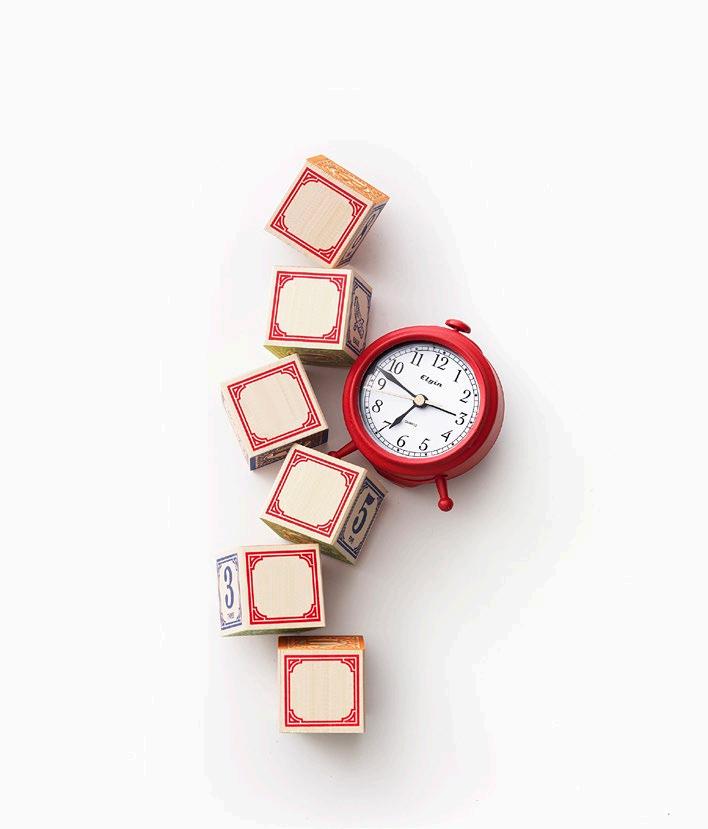
D ?
? O ? AEON (JULY 30, 2014), COPYRIGHT © 2014 BY AEON MEDIA GROUP LTD., AEON.CO.
T
NOVEMBER 2019 • 59 READER’S DIGEST

Foraging
Leaves crunching under foot, baskets filled with squeaky mushrooms, inky sloe berries and a meal made from ingredients you gathered by hand. Is there anything more satisfying than an afternoon spent foraging?
by Anna Walker
BEST
British
OF Autumn
60
INSPIRE

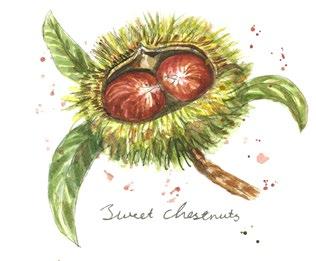
Sweet chestnuts
Nothing spells the coming of Christmas like chestnuts roasting on an open fire, and foraging them is remarkably easy. First brought to the UK by the Romans, Brits have been harvesting sweet chestnuts for thousands of years—simply by keeping a keen eye to the floor.
To reap your own sweet chestnuts, you simply need to find a well-established chestnut tree, and scour the ground around its roots. Look out for their distinctive green, spiny shells—though of course, it’s the shiny dark fruit inside that’s the real prize.
Be sure not to confuse the sweet chestnut tree with its cousin, the horse chestnut tree, whose bounty is wonderful for conker contests, but poisonous to consume. The green shell of the horse chestnut bears small lumpy points, rather than the spines of the sweet chestnut.
Where to find them: Throughout Britain, most populously in the South of England.
Deborah Vernon / a lamy Stock Photo
Hawthorn berries
With a gentle, appley taste, Hawthorn berries make an exciting addition to any autumn larder. Best used to make hawthorn jelly or the traditional hawthorn leather candy, there are plenty of tasty options for this often-overlooked native berry.
Despite being remarkably common, hawthorn berries are classed as a super food, offering an abundance of nutritional and medicinal benefits, including lowering blood pressure, reducing inflammation, aiding digestion and reducing anxiety.
Britain’s most famous hawthorn is the Holy Thorn of Glastonbury, where legend dictates Joseph of Arimathea thrust his staff into the ground, where it spouted and grew

into a hawthorn tree. Though the original no longer remains, its alleged offspring can still be found growing on the same hill and would make for a particularly theatrical foraging backdrop.
Where to find them: Look out for hawthorns in thickets, at the edge of areas of woodland and in hedgerows. The county of Oxfordshire boasts a particularly bountiful crop.

BEST OF BRITISH 62 c hri S
/
Dorney
a lamy Stock Photo

Horseradish
Easily mistaken for dock leaves, horseradish grows wild virtually everywhere in Britain. If in doubt, rub a leaf against your palm—if you’re greeted by that distinctly pungent, mustardy horseradish scent, you’ve found your mark. Horseradish plants are best discovered at first frost, when their leaves will shrivel and turn brown, and harvested upon second frost, when the root is easiest to access.
To unearth your plant, use a garden fork to dig into the ground close to its base and then loosen the earth, so that the root comes loose.
Give it a tug, and you should have in your hand a large, creamy-coloured horseradish root, not dissimilar in appearance to a parsnip.
Where to find it: Banks, hedgerows, uncultivated wastelands and the edges of ditches are usually good places to start.

READER’S DIGEST

Sloes
Gin-lovers rejoice, November brings with it peak sloe season and the abundance of blackthorn bushes growing across the UK, from country to city centre, means there are plenty of berries ripe for the picking. The best time to pick these wild miniature plums is at first frost, but if you can’t wait that long, be sure to freeze your haul. This will cause the berry to split, enabling the gin to pick up their full flavour.
To create the perfect sloe gin, fill a jar or bottle halfway with sloes, and top up with gin and 250g of golden caster sugar. Seal it and give it a hearty shake every day for the next week. After that, it needs rest, so pop it in a dark cupboard for between
two and three months to allow the flavour to fully mature.
Get picking now and you could have a delicious bottle ready for your New Year’s Eve celebrations.
Where to find them: Look out for sloe bushes in hedgerows and along footpaths. London’s Hampstead Heath is surprisingly abundant with sloes.

62 BEST OF BRITISH
64 • NOVEMBER 2019
Oyster mushrooms
Also known as “the lungs of the forest”, mushrooms make for the most satisfying foraging bounty, though proceed with caution, as they’re also the most dangerous. For beginners, the oyster variety is a great place to start—they’re fairly easy to identify and grow in abundance, which is lucky, as they’re one of the world’s most highly consumed varieties.

which should measure 10cm or more in diameter.
Oyster mushrooms can be identified through their namesake appearance—they grow on dead deciduous wood in shelf-like layers which give them the appearance of a cluster of oysters. Their gills should be white and hairless, their stalks squat and their scent distinctly liquorice tinged. Using a good knife, harvest the more mature growths,
Be sure to take a trusted mushroom guide with you and never eat a mushroom if you’re in doubt of its variety.
Where to find them: Almost any damp, wooded area in the UK will be home to oyster mushrooms, but Goblin Combe in Somerset boasts some particularly impressive growths.

65
Bladder wrack seaweed
The benefits to foraging this shiny, slimy snack go beyond your appetite—burst one of the distinctive bubbles and rub it into your hands for a shot of hydration. Back in the kitchen, the younger tips make a delicious addition to salads. To add an intensity of flavour to any seafood-based meal, line a pan with nutrient dense bladder wrack and butter and cook your fish on top.
When foraging, look out for brightly coloured weeds, as those are fresher, and set out at low tide, when the yield will be higher. Be sure to harvest from the sea, where the weed
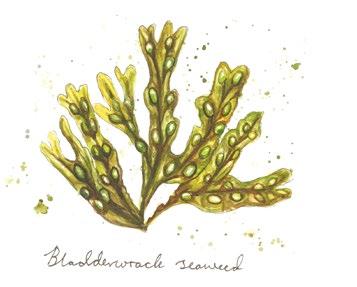
is still alive, rather than gathering dead weeds from the beaches.
Where to find it: Northern Irish beaches offer a rich bounty of fresh bladder wrack, but the weed can be found in most British oceans. Aim to gather from unpolluted tides.

BEST OF BRITISH 66

Crab apples
The fruit of the crab apple tree is tenacious, clinging onto its branches until as late as January. Part of the rose family, these apples are ready to eat when their green or red colour takes on a yellowish hue.
In November, you’ll find an abundant crop for picking, and these tart apples are delicious with pork or added in chunks to a hearty bread-andbutter-pudding. If you’re feeling particularly adventurous, the web offers plenty of recipes to create your own crab apple whisky.
Legend has it that throwing the pips of a crab apple into a burning fire while saying the name of your lover will reveal their fidelity. If the pip explodes in the fire’s heat, your lover has been faithful. If it burns silently, they’ve been untrue.
Where to find them: Britain’s wild apple trees are in decline but look out for them in woods and hedges. Curiously, a wood will commonly home just one crab apple tree, so keep your eyes peeled while hunting down mushrooms and hawthorn berries.
Is there a particularly bountiful foraging spot near you?

Email readersletters@readersdigest.co.uk and let us know
HOW TO FORAGE RESPONSIBLY
Don’t pick anything unless you’re absolutely certain what it is, especially when it comes to mushrooms. Mistaken identity can lead to deadly mistakes. For extra caution, invest in a pocket foraging guide.
Always seek permission from the landowner, or ensure you’re foraging on public land. If in doubt, err on the side of caution.
Respect the land around you and forage no more than you need. Try to stick to abundant plants that will quickly recover from your pickings. It might be tempting to leave with an armful of your discovery but be sure to leave behind food for other foragers, and to ensure nature can continue to thrive.
Be mindful of areas subject to pollution, including roadsides, industrial estates and dog walking territory.
Visit woodlandtrust.org.uk for a full set of foraging guidelines and tips
NOVEMBER 2019 • 67 READER’S DIGEST
If I Ruled The World Mick Hucknall
As frontman of Simply Red, Mick Hucknall has sold more than 50 million albums and this month releases the band’s first LP in four years. He and wife Gabriella are parents to Romy, 12
We’d do better by our youth. People of my generation and older are failing young people when it comes to the environment. There have been persistent warning signs over a period of many years about, say, carbon dioxide and methane and it’s not that we’re not doing anything— we’re just not doing nearly enough. I see planes passing overhead every 30 seconds and that’s got to be a serious environmental problem. Why have we allowed people to make so many aeroplanes without

putting environmental checks on them? Where’s the development for solar-, wind- and battery-powered jet engines?
I’d stop this obsession with building borders and walls. Brexit supporters and Donald Trump are synonymous in that respect, if you ask me. They seem preoccupied with putting up borders and walls when we should be doing precisely the opposite. We need fewer walls, fewer borders and more interaction, more free trade, more open markets and more unified action to make this world a better place.
I would ban Donald Trump. Not just that, I’d also put him in jail. He thinks he’s starring in an episode of
68 • NOVEMBER 2019
© DEAN CHALKLEY
The Sopranos. He’s a thug and he should be locked up.
People would stop indicating after they’ve turned. It happens so often when I’m driving that the car in front of me decides to turn and then the driver indicates. What’s that all about? I just don’t get it. It’s like, “Oh, I forgot to indicate, I feel guilty so I’ll do it now.”
Concertgoers would put their iPads down. I want people to have a good time and I’m on the side of letting them do what they like, so I wouldn’t stop them using iphones to take pictures and capture that “special moment.” But with iPads it’s a bit much. The compromise is: by all means use a phone but it’s a very selfish act to use your iPad. When you’re behind someone in an arena you have rows of seats so you already have a limited view, but with holding up an iPad it’s like sticking an extra head in there to further impede the view of the person behind you.
Parents would listen to their kids. My girl is 12-years-old now and I love seeing her forge her own personality, and I think it’s really important to listen to her. Kids can get confused and feel like they’re all over the place, but if they know you’re listening they’ll share more with you. With any of the worries she has about the world or about growing boobs or
menstruation and all that stuff, I want her to feel she can talk to me and that I’m not passing judgement but am helping her find her way.
Everyone would enjoy wine as much as I do. Rod Stewart and Jools Holland collect train sets; my hobby is wine. Ironically, I’m not a heavy drinker, more a moderate one. I drink less than half a bottle a day and I abstain two days a week but I love, love, love wine—how it varies throughout different regions in the world, how different grapes taste differently and how different flavours accompany certain foods.
Happiness would be a default. Maybe I sound angry from all this ranting but I’m actually a very happy person. I have a song on the new album called “Don’t Do Down” and I don’t do down. I try to use happiness as a default mechanism and to keep it in my mind to go, Are you annoyed about something? Then try and find a solution that makes you happy. It’s the best way to live. You don’t know what’s going to happen in the next hour or the next day, so just stay happy. n
As told to Simon Button
The new Simply Red album, Blue Eyed Soul, is out on November 8 on BMG.
Tickets for their All The Hits! 2020 tour are on sale now through simplyred.com
NOVEMBER 2019 • 69
INSPIRE

LOOKING TO GIVE YOUR BODY A BREAK FROM MUSCLE ACHES AND PAINS?
THE HeatTens IS HERE TO HELP!






















As the population’s average lifespan continues to increase, so is the prevalence of chronic pain. We all experience pain, and no matter what your age, lifestyle or fitness level, it may be time to stop letting pain affect your everyday life, with HeatTens by OMRON

their medical conditions both at home and in clinical practice across Europe, Middle East and Africa. With over 200 million blood pressure monitors sold worldwide, OMRON also has extensive expertise and innovative in the pain relief field.
The HeatTens is a unique pain reliever that combines two complementary therapies – HEAT and TENS – to relieve muscle and joint pain. It also can relieve stiffness and numbness across the body.
It can be said that as a nation we strive to appear as happy and pain-free as possible on our social media feeds, when in reality the pain we suffer day-to-day is rarely addressed. In fact, according to research from Imperial College London, almost half of all UK adults – 28 million of us - are living with chronic pain. Many do not take action to reduce and relieve this – but a drug-free alternative is available.
Throughout its 85-year history, OMRON Healthcare has been striving to improve lives by developing innovative products that help people prevent, treat and manage
The HEAT increases metabolic activity, warms and relaxes the muscle for soothing relief while improving the blood circulation, while the TENS stimulates your body’s natural pain-relieving mechanisms using electrical pulses.
But what does TENS stand for? “TENS” stands for Transcutaneous Electrical Nerve Stimulation. This is a technique that aims to relieve musculoskeletal pain using a low-voltage electrical current. This means that it uses electrical impulses delivered by a TENS unit via electrodes placed on the skin over a nerve pathway, or close to the painful area. And at home, a TENS machine is easy

to use for symptomatic pain relief including joint pain and muscle pain.
TENS PROVIDES PAIN RELIEF AND HAS A TRIPLE EFFECT:
1. Block the pain message
2. Trigger the release of endorphins (body’s natural pain killer)
3. Improve blood circulation
TENS therapy has been used for over 20 years by medical professionals such as physiotherapists and chiropractors.
HeatTens has 9 pre-set programs designed for your back, shoulders, joints, arms, legs and feet, as well as 3 massage modes and 20 intensity levels. This device also features 2 different heat intensities, as well as the option to use it without any heat.
Recommended maximum therapy duration of HeatTens is 30 minutes.
The HeatTens is great if you are experiencing pain in your back, muscles or joints after a long run, a lengthy workout, or other physical activities. It can also be used alongside prescribed pain relief medication.
It is time to give your body a break from body aches and pains. It is time for HeatTens.
For more information about HeatTens by OMRON, please visit www.omron-healthcare.co.uk n
COMPETITION
WIN A HeatTens PAIN RELIEVER
(RRP £128.99) FROM OMRON SAY
Reader’s Digest has teamed up with OMRON Healthcare, the global leader in the field of clinically proven, innovative medical equipment for home and professional use to give our readers the chance to win a HeatTens Pain Reliever.
It can be said that we strive to appear happy on our social media feeds, with the reality of negatives such as pain being unshared. Well perhaps it’s time to not let pain affect your everyday life with HeatTens.
Using the combination of two complementary therapies HEAT and TENS technology, the HeatTens can help relieve different types of muscle and joint pain.
With the powerful combination of soothing heat and TENS technology, HeatTens reduces and relieves muscle and joint pain, plus stiffness and numbness in the back, arms, legs, shoulders and feet. The triple-action TENS Technology (transcutaneous electrical nerve stimulation) increases metabolic activity, relaxes the muscles and soothes pain. HeatTens also triggers the release of endorphins, the body’s natural pain reliever, and improves blood circulation.
Tired legs or feet after a 5km parkrun? Feeling numb after a lengthy workout session? Or perhaps day-to-day movements are causing pain in your back or muscles? HeatTens will apply electrical nerve stimulation to the surface of the skin near the site of the pain enabling it to perform as your at-home drug-free pain reliever.
To be in with a chance to win a HeatTens from OMRON, all you need to do is visit readersdigest.co.uk/omroncomp
GOODBYE TO MUSCLE AND JOINT PAINS!

It’s vital for our health, wellness and happiness, say the world’s leading neuroscientists
Power Touch The
By Anne Mullens
Every two or three months, Thyago Ohana goes out on the busy streets of Vienna with a sign saying “Free Hugs.” The handsome 32-year-old Brazilian, who works in international trade at India’s Vienna embassy, chooses a popular locale, like the historic shopping street, Kaerntner Strasse. There he opens his arms to anyone who wants a hearty embrace
41 73
HEALTH
He does it because back in 2012, when he was feeling very stressed and anxious during a visit to Paris, a stranger gave him a free hug. He’s never forgotten how it filled him with unexpected calm and joy.
For those who take up his offer, the hug makes them laugh and smile. But sometimes it does more, as when an elderly woman in a tour group stopped and watched him. The group moved on, but she lingered and asked, “Can I have a hug?”
“Of course you can!” said Thyago who wrapped his arms round her.
infant is deprived of loving social touch for the first two years of life, then all sorts of disasters unfold.”
Citing the terrible experience of some young children who were deprived of loving touch in Romanian orphanages during the 1980s and 1990s, Linden describes how not only did they have psychological and intellectual difficulties, but their immune systems did not develop properly, nor did their digestive systems.
SPECIAL FIBRES TRANSMIT SENSATIONS OF TOUCH, CONNECTING US TO OTHERS
When they broke their embrace, she kept holding onto his shoulders and looked into his eyes. “Thank you,” she said. “I can’t remember the last time I was hugged this way.”
It’s a memory that still makes Thyago emotional. “It was a really powerful moment of human connection. It's why I keep doing it.”
Of our five senses, our sense of touch is the one we are most apt to take for granted and yet the one we can least do without.
“A child can be born blind or deaf and they will grow up just fine, with no cognitive impairments,” says US neuroscientist David J Linden, author of Touch: The Science of Hand, Heart, and Mind. “Yet if an
That’s one reason why when babies are born, the naked infant is now usually placed on their mother’s naked skin. Research studies now encourage the regular stroking and holding of premature infants, even through special portholes in incubators. It's also a reason why classes in infant massage techniques have gained passionate supporters worldwide.
Elsie Peña Tretvik, of Molde, Norway, sought out such a class because she wanted to comfort and bond with her colicky infant daughter, Maya. Born and raised in Costa Rica, Elsie was visiting home with three-month-old Maya when her daughter was crying for up to three hours each evening.
One of her old friends, Paola Rodríguez, just happened to be the CEO of the International Association
74 • NOVEMBER 2019 THE POWER OF TOUCH

of Infant Massage, whose more than 30 international chapters include one in Costa Rica. When Elsie contacted her looking for help, she suggested Elsie take one of the organisation’s five-day courses.
The course changed Elsie’s life. “Not only did I learn how to help Maya relax and relieve her colic, I learned how to read her emotional cues and build my confidence as a mother.” She decided to certify as a teacher in infant massage, and now offers the course to parents in Molde. “The benefits are huge. My husband and I took the course together,” said Elsie. Having recently given birth to her second child, she will teach Maya, now two, how to help and do some gentle strokes.
It's only in relatively recent years
that science has begun to understand the highly complex system of nerves, sensors and receptors that link our skin and brain to our environment and the other people in it. Says Linden: “There is still so much we don’t know about various touch sensations.” We do know, however, “there are separate sensors for texture, vibration, pressure and itch,” he says.
One of the leading touch researchers in the world is Dr Håkan Olausson, professor of clinical neuroscience at Linköping University in Sweden. He was part of a team that found special touch fibres, called C-tactile afferent fibres, that are responsible for registering and transmitting the emotional meaning of gentle, slow strokes and caresses. These nerves respond optimally when touched at around 32°C—the temperature of a human hand. “They are particularly sensitive to caresses by other people, but also respond to many other types of touch, such as pressing on the skin.” says Dr Olausson. When the CT fibres don’t work properly, it may undermine making emotional connections to others.
Research led by neuroscientist Francis McGlone, at Liverpool John Moores University, has found that children on the autism spectrum may have a difference in the functioning of their CT fibres that causes them to feel another person’s soft touch as unpleasant.
NOVEMBER 2019 • 75 READER’S DIGEST
PHOTO: © JAN COBB PHOTOGRAPHY/GETTY IMAGES
As we age, our sense of touch gets less sensitive, but Dr Olausson and another team of researchers found that the pleasantness of touch remains and is even enhanced with age.
Alas, as Thyago Ohana knows, the elderly among us, while appreciating touch more, may be the most touchdeprived. Linden notes the research is clear about the benefits of massage and other forms of social touch for the elderly, but it hasn’t yet been translated widely into care homes or other senior services.
Dr Manuel ArroyoMorales, is a professor of physiotherapy at the University of Granada in Spain, where researchers study “the effect of hands on the human body.” He's interested in the impact of massage therapies on cancer patients, finding that it partially reduces pain and fatigue, strengthens the immune system and reduces anxiety. Importantly, they've found that some of the outcomes depend on the attitude of the patient towards touch. It's the specific type of massage and the “consensual touching relationship” that provide the key benefits, says Dr Arroyo-Morales.
with two brain tumours. One was a benign meningioma and the other a more aggressive oligodendroglioma. She named them Melanie and Ollie. “They're part of me; I needed to accept them.”
RESEARCH TELLS US THAT MAXIMIZING TOUCH IN OUR LIVES IS A GOOD THING
Joannie McCutcheon, 65, knows that first hand. In 2005 she was living in Amsterdam, working in a multi-national company as an IT specialist, when she was diagnosed
Joannie had surgery to remove part of Ollie (the other part was inoperable), which is typically fatal within a few years. Separated from her husband, with grown children, in 2007 she moved back home to Scotland and in 2015 became a volunteer with the Iris Cancer Partnership, a charity that provides free massages to cancer patients from specially trained therapists. Joannie applies her IT skills on the board of Iris, and as a patient receives a massage every three weeks from her own personal massage therapist and now friend, Angela Secretan. “I can go in feeling exhausted and headachey. She’ll massage my head or my back, and she does reflexology on my feet. She seems to know instinctively what I need and together we decide what is best for me at that moment. It's always just gorgeous and I come out feeling that everything is OK again.”
Joannie feels her regular massages, as well as her adopting the attitude that her tumours were a gift that brought new relationships into her
76 • NOVEMBER 2019 THE POWER OF TOUCH

life, have kept her alive after others with the same diagnosis have died. As well as sustaining life, the emotional connection of touch therapy can also have a profound and moving effect at life’s end.
Simon Robey knows that well. He’s the coordinator of complementary therapies and the interim head of supportive care for St Joseph’s Hospice, in east London. As part of its care the hospice provides, all free of charge, a wide range of touch therapies not only to their dying patients, but to their loved ones and families, who are all under an inordinate amount of stress.
Simon Robey describes the experience of a young woman, in her early thirties, who was hours away from death. The family was supportive, staying by her bedside day and night, but the therapist offered additional support massaging the dying woman’s hands, legs, feet. “She was drifting in and out of consciousness... but we all noticed
she became remarkably more relaxed; she really responded to those sensory touches. For the family there was something reassuring in the way that it helped to make her final hours more comfortable.”
So how do we get more loving touch, while we are hale and hearty, into our dayto-day lives? For some, the answer is “cuddle parties”— non-sexual three-plus-hour social events in which participants do just that—cuddle. The Irish Cuddle Salon is held in Dublin on the third Sunday of every month. Wendy Stephens, 33, heard about it from a friend. As a single woman, she was nervous and thought it might be uncomfortable. But she found it a “beautiful, grounding experience” and hasn’t missed a month ever since. It improves her sleep and her appetite and decreases feelings of loneliness.
Neuroscientist David J Linden says however you do it, “maximising touch in your life is a good thing”—whether a therapeutic massage, holding hands, petting a dog, going to the hairdresser, hugging our kids, our partners or even a stranger.
“When we put our hands on each other,” wrote Linden with co-author Martha Thomas in a recent issue of AARP The Magazine, “we’re tapping into deep associations between touch and emotion that are kindled at the dawn of life.” n
READER’S DIGEST NOVEMBER 2019 • 77

BABY BOOMERS ‘BRUSHING OFF’ MENTAL HEALTH PROBLEMS
A recent report by health insurer Bupa has found that the baby boomer generation appears to be neglecting psychological wellbeing to the detriment of mental health.
The boomers may be described as being wealthier, more active and more physically fit than the generations that went before. But when it comes to the way they feel, behave and exist emotionally, it appears they’re just not making a big enough noise.
An issue that shouldn’t be ignored
In reality, they’re actually in a high-risk group when it comes to mental health issues.
Figures show that around two thirds suffer from symptoms with anxiousness, continuous low mood, feelings of hopelessness and insomnia.
Older isn’t necessarily wiser
Interestingly enough, the group of 55+ people surveyed seem to behave
differently from younger generations. They’re less likely to gauge things like stress and depression as problems and don’t feel as comfortable talking about mental health.
Many keep problems entirely bottled up. One in four (27%) tell no one about these symptoms, with fewer confiding in a partner or friend than younger generations and less than half consulting a doctor.1
Less than one in three over 55s feel confident in recognising the symptoms of conditions like depression and anxiety, compared to nearly half of 18-34-yearolds and even those who do seek help delay by over 50 days on average.2
Why they feel unable to act
Lack of action stems from a lack of
PARTNERSHIP PROMOTION

awareness that the symptoms could indicate a mental health problem. One in five (22%) think their symptoms ‘don’t indicate anything serious’ and others say mental health simply ‘doesn’t affect me’.
Early action improves outcomes
These issues can be headed off by those north of 55 if they seek help as soon as symptoms come calling.
That’s why Bupa’s urging people to come forward early when it comes to dealing with mental health problems. It’s just as important as physical health and starting the conversation early –whether it’s with family, friends or mental wellbeing practitioners – can make a huge difference to getting things back to normal.
Pablo Vandenabeele, Clinical Director for Mental Health at Bupa UK, says: “Mental health issues can affect us at any age and it’s important to seek support without delay, as early diagnosis and treatment can improve recovery rates. If you or a loved one is struggling with their mental health, it’s important to
seek medical help. Bupa’s Mental Health Direct Access offers fast access to a specialist without the need for a GP referral.”
How Bupa can help
Bupa’s purpose is helping people live longer, healthier, happier lives.
In order to do this for mental health as well as physical health, they offer comprehensive support that puts them heads above all other leading UK insurers;† with Bupa By You health insurance that covers more mental health conditions and for longer. That’s in addition to their nationwide network of clinical resources for physical problems.
READER’S DIGEST OFFER
10% off Bupa By You health insurance
To help more people access Bupa’s support to keep body and mind in the best shape, they’re offering 10% off Bupa By You health insurance*.
To get a quote, call 0808 302 4214 or visit Research conducted among 2,152 UK adults by Opinium Research, 19-22 March 2019.
bupa.co.uk/readers-digest
184% of 18-34 year olds tell at least one person about their symptoms. 43% tell a partner and 50% tell a friend, compared to 33% and 28% respectively for over 55s
231% of over 55s said they were fully aware of depression and 26% are fully aware of anxiety, compared to 46% and 46% respectively for 18-34s
†As of May 2019, based on internally conducted research of the consumer health insurance market. Refers to standard mental health cover when this is included in the selected health cover product.
*Applies to Reader’s Digest members on quotes for new Bupa By You policies. Discounts will be reviewed on 10/09/2020 and any changes will apply to renewals and new quotes thereafter. Quotes are valid for 14 days. T&Cs apply.
Reader's Digest introduces Bupa health insurance. Bupa health insurance is provided by Bupa Insurance Limited.
Bupa Insurance Limited is authorised by the Prudential Regulation Authority and regulated by the Financial Conduct Authority and the Prudential Regulation Authority. Arranged and administered by Bupa Insurance Services Limited, which is authorised and regulated by the Financial Conduct Authority.

Unexpected Heroes
Humpback whales put themselves in danger to save the lives of other species
by Elin Kelsey
80
INSPIRE
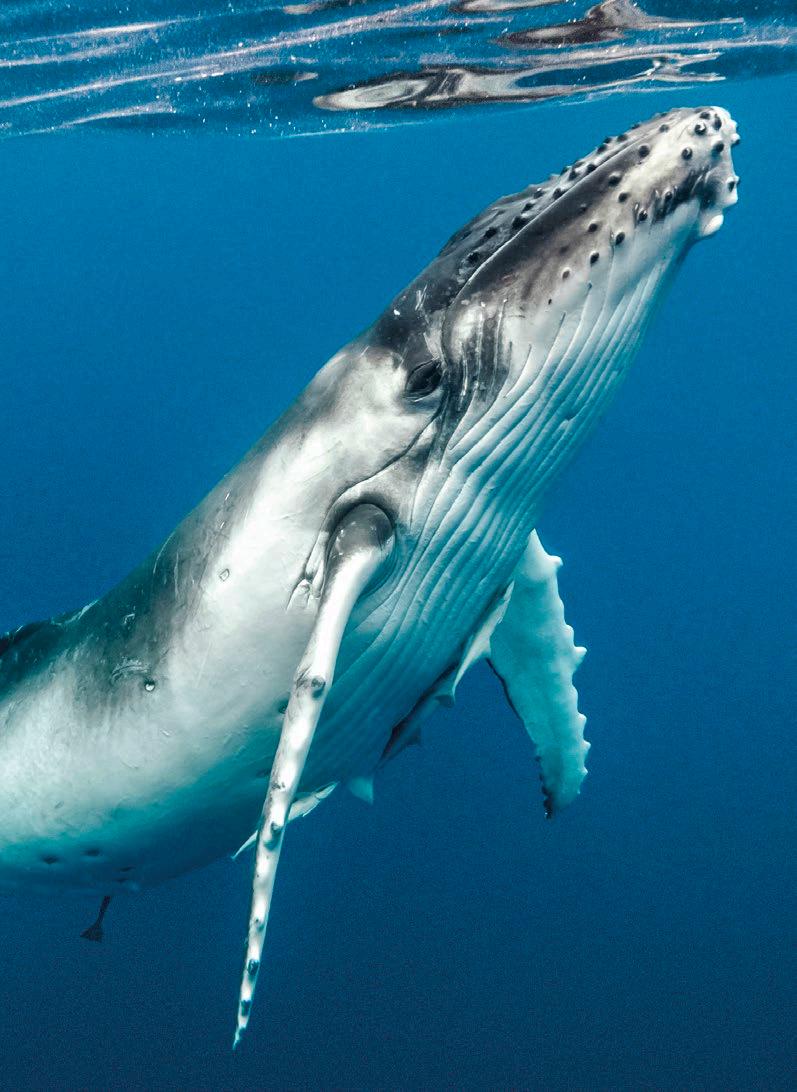
The whales use their enormous flippers for protecting themselves and fighting predators
irst-person accounts of animals saving other animals are rare.
Robert Pitman, a marine ecologist with the United States National Oceanic and Atmospheric Administration, describes a revelatory encounter he witnessed in Antarctica in 2009.
A group of killer whales had washed a Weddell seal they were attacking off of an ice floe. The seal swam frantically toward a pair of humpbacks that had inserted themselves into the action. One of the humpbacks rolled over on its back, and the 63 stone seal was swept onto its chest, between the whale’s massive flippers. When the killer whales moved in closer, the humpback arched its chest, lifting the seal out of the water. And when the seal started slipping off, the humpback, according to Pitman, “gave the seal a gentle nudge with its flipper, back to the middle of its chest. Moments later, the seal scrambled off and swam to the safety of a nearby ice floe.
“That incident convinced me,” he says. “Those humpbacks were doing something we couldn’t explain.”
Pitman started asking other researchers and whale watchers to send him similar accounts. Soon he was poring through observations of 115 encounters between humpbacks and killer whales, recorded over 62 years. “There are some pretty astonishing videos of humpbacks charging killer whales,” he says.
Helena Dove
In a 2016 article in Marine Mammal Science, a prominent scientific journal, Pitman and his co-authors describe this behaviour and confirm that such acts of do-gooding are widespread. They have been taking place for a long time and have been seen in locations all over the world. “Now that people know what to look for, especially people out on whale-watching boats, they see it fairly regularly,” Pitman says. “Everybody now understands that this is going on.”
But knowing that something is

A FULL-GROWN 30- TO 40-TON HUMPBACK PRESENTS A FORMIDABLE FORCE AGAINST A KILLER WHALE
happening and understanding why it’s happening are two different things. Pitman and his co-authors openly ponder the meaning of these encounters. “Why,” they wrote, “would humpbacks deliberately interfere with attacking killer whales, spending time and energy on a potentially injurious activity, especially when the killer whales… were attacking other species of prey?”
Mammal-eating killer whales attack
F
82 • NOVEMBER 2019 UNEXPECTED HEROES
photo: G Michael S M ith it W p /Shutter S tock
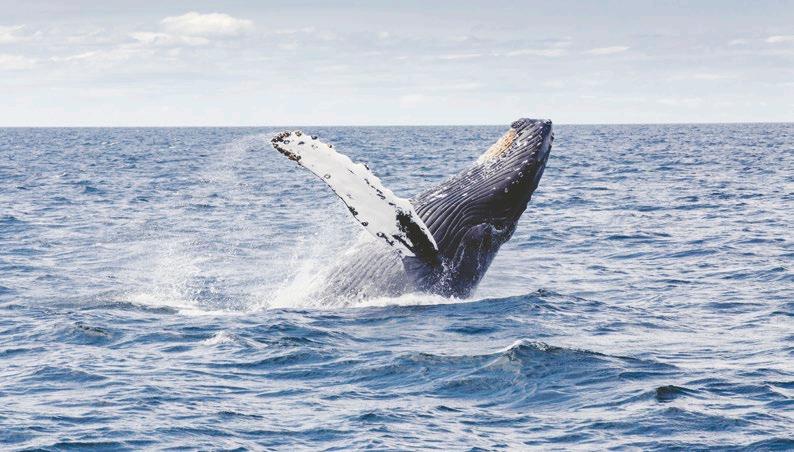
young humpbacks, so it’s possible that humpbacks mob them as a generalised anti-predator behaviour. It could also be that specific humpbacks, individuals that have survived a killer whale attack when they were young or have lost a calf to killer-whale predation, respond to these traumas by going on the offensive. Sharpe concurs that the severity of a past interaction could affect an individual.
A full-grown 30-to-40-ton humpback presents a formidable force against a killer whale, which weighs in at a maximum of six tons. Each enormous flipper can measure up to 16ft. Razor-sharp barnacles encrust the knobby leading edge of these appendages, and the whales brandish them with great dexterity. Humpbacks are the only species of baleen whales to carry their own
offensive and defensive weaponry. Though killer whales have teeth and are more agile, a blow from the massive humpback tail or flipper could prove fatal.
Intriguingly, humpbacks don’t just stumble upon killer-whale attacks. They race toward them like firefighters into burning buildings. And like those rescue workers, humpbacks don’t know who is in danger until they get there. That’s because the sound that alerts them to an attack isn’t the plaintive voice of the victim. It’s the excited calls of the perpetrators. Pitman believes humpbacks have one simple instruction: “When you hear killer whales attacking, go break it up.”
But humpbacks also display remarkable capacities for subtlety. Sharpe calls them “hypercultural beings,” pointing out how adaptable
NOVEMBER 2019 • 83
photo: tho M a S kelley/un S pla S h
they are, and good at learning from each other. “Their ability to pick up on social nuance in some ways far surpasses ours,” he says.
When I ask if humpbacks are aware of the suffering of others, which is one of the defining characteristics of compassion, he shares a story of a humpback that died in Hawaii about

COMPASSION, IT TURNS OUT, IS INNATE— AND DEFINITELY NOT LIMITED TO OUR SPECIES
a decade ago. “The whale had its head down in the water and was no longer breathing,” says Sharpe. “It attracted a lot of unusual interest from other humpbacks—they were approaching it and caressing it.”
Similar behaviour has been observed in mother whales that carry their dead young around with them for hours after they have died, seemingly unwilling to let go.
So are humpbacks compassionate? Scientists, Sharpe tells me, shy away from using the same descriptors we use for humans. “What's exciting about humpbacks is that they're directing
their behaviour for the benefit of other species,” he says. “But there’s no doubt that there are important differences between human compassion and animal compassion.”
When I pose the same question to Pitman, he agrees. “When a human protects an imperilled individual of another species, we call it compassion. If a humpback whale does so, we call it instinct. But sometimes the distinction isn’t all that clear.”
We now recognise cultural differences within whale, primate, elephant and other species in ways that were unimaginable just decades ago. Studies of animal emotions proliferate, and with them come challenging questions about how to best interpret what looks like compassion and altruism in other species. Just how these acts differ from our own behaviours may be hard to pinpoint.
In an attempt to decipher what qualities of compassion might be uniquely human, I binge-watch videos. I am captivated by footage from the Max Planck Institute for Evolutionary Anthropology showing a series of experiments in which a toddler voluntarily totters across a room to assist an apparently clumsy researcher who needs help reaching objects or completing simple tasks. The same basic helpful behaviour happens later in the video, when the experiment is repeated with chimpanzees.
What’s powerful about these tests,
84 • NOVEMBER 2019 THE GOOD LIFE


according to Felix Warneken, the researcher who led the study and the director of the Social Minds Lab, in the psychology department at the University of Michigan, is that they challenge the strongly held belief that we need to be taught to be altruistic through social norms. His findings indicate otherwise.
Chimpanzees, as well as children too young to have learned the rules of politeness, spontaneously engage in helpful behaviours, even when they have to stop playing or overcome obstacles to do so. The same results have been duplicated with children in Canada, India and Peru, as well as with chimps at the Ngamba Island Chimpanzee Sanctuary in Uganda and other research centres around the world. The chimps helped people they knew and human strangers, too.
Compassion, it turns out, is innate— and definitely not limited to our species. Human beings and other animals have what Dacher Keltner, a professor of psychology at the University of California, Berkeley, calls a “compassionate instinct.”
Steve Cole, a genomics researcher at the University of California, Los Angeles reveals an intriguing insight into threat biology that might shed further light on why humpbacks willingly enter into dangerous altercations with killer whales. He explains that scientists used to think that the circuitry for detecting and responding physiologically to threatening circumstances was there to protect the survival of the individual. But that is no longer the case.
86 • NOVEMBER 2019
photo: hu M berto-braojo S /un S pla S h
Studies in threat neurobiology suggest that those circuits are there to defend the things individuals care about. “This is why you get soldiers running into a hail of gunfire for the country they love,” says Cole. “These people are in adverse environments, but they're acting as if they are in nonthreatening environments simply because they are attached to some purpose or cause that’s greater than their own individual well-being.”
I wonder what humpback whales care deeply enough about to actively swim into battle with killer whales. When I ask Pitman, he tells me that, ultimately, it still comes down to selfishly preserving their own kind. He believes that their occasional rescues of humpback calves create a strong enough motive for them to rush in to help, even if it means they end up saving sunfish, sea lions, dolphins and a grey-whale calf every now and then. “It’s the net effect that is working for them,” he explains. All altruism involves some benefit
Angela Davies
for the helper, Cole agrees. According to him, it’s biologically difficult to call anything “true altruism” because, as he says, “Helping others almost always doses us with some kind of dopaminergic reward.”
Indeed, the happiness we derive when we act on behalf of the greater good shows up in our cells as a better immune response profile, says Cole. While we might feel just as happy eating ice cream as we do volunteering at a beach cleanup, at a cellular level, happiness derived from meaningful service to others is correlated with positive health benefits.
Sharpe says it’s important to step back and appreciate the wonder of the act itself. “It’s easy to get lost in the nuance and come up with high standards of how you interpret this behaviour,” he says. “But the fact is, you have seals on the bellies of humpbacks. You know, it’s just a really cool phenomenon.”
A Town Called Nothing
After submitting six seperate proposed town names in order that they might be given a post office, and having all six suggestions rejected, citizens of a village in Texas, US, responded by saying, "Let the post office be nameless and be damed". The US government accepted this suggestion, and so the town of Nameless was born. Sadly the post office only stood for a decade before closure, but the old Nameless School House still remains, and residents meet on the second Monday of every month in order to promote its preservation.
SOURCE: HILLCOUNTYEXPLORER.COM
READER’S DIGEST NOVEMBER 2019 • 87
© 2017, e lin k el S ey. Fro M h akai Ma G azine ( a u G u S t 15, 2017). hakai M a G azine.co M

waysto improve your skin as you age
Despite the inevitability of ageing skin, there are things you can do and steps you can take to reduce the impact. Here are our top five ways to improve the condition and look of your skin as you age
1. The biggest cause of external skin ageing is oxidative stress
This is triggered and accelerated by a number of lifestyle factors. You should take steps to reduce the level of oxidative stress your skin is exposed to by ensuring you wear a high factor spf every day to protect your skin from the sun. If you smoke, take steps to reduce the amount you smoke or give up completely. Shield your skin against the harmful effects of pollution by investing in anti-pollution beauty products.
PARTNERSHIP PROMOTION


2. Take collagen supplements
From around the age of 25, collagen, one of the skin’s building blocks decreases by 1% each year – as a result our skin structure becomes compromised and less supple which in turn promotes wrinkling. If you struggle to consume all the right proteins, vitamins and minerals on a daily basis to aid collagen production then invest in a collagen supplement to complement your diet. We’d recommend the Prime Fifty hair, skin and nails formula, which has been created for those in their 50’s and beyond and uses an advanced age specific multinutrient formulation comprised of the most essential vitamins, minerals and natural extracts.
3. Adapt your diet
Incorporate lots of foods that support and promote good skin health. Although there isn’t any food that will erase your crow’s feet or make you feel 23 again, a healthy diet full of anti-ageing foods can boost skin quality, improve your immunity and much more. Pack your diet full of vibrant foods that are loaded with healthy fats, water, antioxidants and essential nutrients and your skin will show its appreciation.
4. Introduce a good skincare regime
Skin will age quicker if it’s not properly cared for or you use products that irritate the skin. Introduce a thorough cleansing
ORDER YOUR 3 MONTH SUPPLY OF THE PRIME FIFTY HAIR, SKIN & NAILS COLLAGEN AND VITAMIN FORMULA AT PRIMEFIFTY.CO.UK/RD OR CALL 07383 443 625
10% OFF FOR READER’S DIGEST READERS USING CODE DIGEST10
routine – using gentle products that are appropriate for your skin type and cleanse your skin at least twice a day to remove dirt and grime build up. Don’t scrub your face, always use gentle upward motions and use moisturiser every day as it traps water in your skin and gives it a more youthful appearance.
5. Improve your blood supply and circulation
Poor blood supply to the skin can hinder the delivery of key nutrients and oxygen to its surface and it can become duller, less hydrated and can lead to premature ageing. Blood flow also helps to carry waste products away – flushing cellular debris including free radicals out of the system and effectively cleansing your skin from the inside. The best way to improve blood flow is to participate in regular cardiovascular exercise and keep hydrated. When you experience stress this can also impact your circulation as your blood vessels constrict - look at ways to manage your stress to help with this. Massage for example, not only helps with stress management but will also help improve your circulation through the lymphatic and cardiovascular systems. n

90
Chicago's Cloud Gate is nicknamed "The Bean" for its shape

SWINGING Chicago
TRAVEL & ADVENTURE
Simon Button investigates the exhilarating jazz scene and its history in the Windy City
Cutting his teeth as a jazz singer for Tommy Dorsey’s big band in Chicago in the late 1940s, New Jersey-born Frank Sinatra adored the city so much he returned time and again as a solo artist. He also went on to sing its praises not once but twice, landing himself two signature tunes; a 1957 cover version of the 1920s standard "Chicago (That Toddlin’ Town)" and declaring it to be "My Kind Of Town" seven years later.

joint to be jumping and, although much has changed in the subsequent near-century, it still is.
It’s no wonder this Louis Armstrong fan would be drawn to a city where Armstrong himself had journeyed from New Orleans in 1922. When Louis got there as a wide-eyed musician following in the footsteps of his mentor Joe “King” Oliver, the trumpeter extraordinaire found the

My visit to the Windy City (thus nicknamed not, apparently, because of the breeze that blows in off Lake Michigan but because of the hot air spouted by politicians bidding to host the 1893 World’s Fair) is timed to coincide with the annual jazz festival as a starting point to explore where the genre is currently at in the place that helped put it on the map.
The Blackstone Hotel is my bolthole for the first three nights and it proves to be elegant and beautifully furnished, with huge rooms, a stunning lobby where President Truman used to play the piano, a breathtaking ballroom that was used in The Untouchables movie and a basement barbershop where Al Capone got his hair cut.
The hotel is also steeped in music history, having played host to the
SWINGING CHICAGO
Louis Armstrong
92 • NOVEMBER 2019
Frank Sinatra

likes of Lena Horne and Nat King Cole—which ties in nicely with my first visit to the 41st Annual Chicago Jazz Festival in Millennium Park, where the opening night headliner is Freddy Cole, playing an emotional tribute to his late brother in the huge outdoor Jay Pritzker Pavilion.
Prior to the concert I take in a stirring performance by veteran trumpeters Pharez Whitted and Corey Wilkes at the Cultural Center, then sit down for a chat with 59-yearold Whitted—who has played with everyone from George Duke to The Temptations and who, through his work for youth programmes, is one of the locals helping keep the musical genre alive and well.
“This is one of the most important cities in the evolution of jazz,” he tells me, “because it is where many of the jazz musicians from the South
ventured to first.”
Jazz’s roots date back to the late 19th century in New Orleans; a fusion of blues and ragtime which soon caught on in Chicago too, firstly in the black neighbourhoods before eventually crossing over into the mainstream. Armstrong moved to the Windy City during the Great Migration of African-Americans from the South, many of whom were musicians poised to take advantage of Chicago’s flourishing jazz scene, where it evolved into a more freeform, improvisational genre.
Pharez laments the loss of intimate clubs (like Katerina’s and Bucket O’Suds) and the scene’s sense of community, saying: “Musicians used to hang out more and share ideas, but you don’t see that as much today.”
Purists may also lament the fact
NOVEMBER 2019 • 93
Freddy Cole
Xinhua / a lamy Stock Photo
that the one-time underground genre has lost some of its cool, with concerts in big venues like the Symphony Center and the Pritzker Pavilion attracting the sort of upscale crowd you’d never find in snugger nightspots. But the jazz concert as event is nothing new; Chicago’s very own Benny Goodman played New York’s Carnegie Hall as far back as 1938. And the free-for-all jazz festival has smaller satellite stages and citywide events, and there are still plenty of joints and dive bars.
Pharez is happy to see jazz being played out across all entertainment
platforms. “Small spaces, clubs, theatres, festivals—it’s all good,” he smiles.
And he’s thrilled to be joined on stage by 18-year-old upright bass player Micah Collier, who is a brilliant musician as well as a young ambassador for jazz. “A lot of young people aren’t hip to it and they think it’s old-school music for the older generation,” says the native Chicagoan, “but for me it’s all about freedom. It’s about expressing yourself and having a simultaneous conversation with others on the bandstand.”

Some of Micah’s sportsminded friends were sceptical at first. “But over time they’ve come to gigs and they’re like, ‘Oh, jazz isn’t boring at all’,” he grins.
The next day I hop on a bus for the "Chicago Crime Tour," which sounds cheesy but actually turns out to be really informative. Mobsters, prohibition and jazz went hand-in hand in the 1920s and 30s, with bootlegger and mob boss Al Capone booking musicians for his numerous illegal speakeasies such as the long-standing Green Mill Cocktail Lounge.
When I visit the Green Mill that night I’m happy to discover it’s still very much the
94 • NOVEMBER 2019 SWINGING CHICAGO

dive bar depicted in the 1957 film
The Joker Is Wild—in which Sinatra (no stranger to the Mob, of course, although he always denied any direct connection) played the singer Joe E Lewis, who had his face slashed and throat mangled when he refused to perform at the uptown venue.
Today it attracts a boisterous crowd, whose banter doesn’t seem to bother jazz organist Chris Foreman—a Friday night fixture at the Green Mill who tells me between sets: “People are here to listen and they’re also here to talk. I give them room to do both.”
Blind since birth and now in his early sixties, Chris is cheered by the fact “more young people are coming to shows and there are more young musicians”, and like Pharez he’s not a snob when it comes to where fans get their jazz fix. “Appreciation is
appreciation. The important thing is the music. It’s about personal expression and it’s unique in that everybody has their own voice.” He laughs. “I’m still working on mine.”
The following morning I do the Architecture Center’s "Historic Treasures Of Chicago’s Golden Age Walking Tour," which takes in such stunning sights as 1920s Art Deco

D Gue S t Smith / a lamy Stock Photo
The front of the Green Mill Cocktail Lounge

masterpiece Carbide & Carbon Building (designed to look like a prohibition-defying champagne bottle) and the breathtaking lobby of the Palmer House hotel.
The Palmer Hotel is my place of residence for the last two nights of my visit and it’s hallowed ground for jazz enthusiasts, since it was in its legendary Empire Room that Sinatra first sang with Dorsey’s orchestra and such icons as Armstrong and Ella Fitzgerald performed.
The guest rooms are a bit dated but they’re nicely quiet compared to the always-buzzing Lockwood bar and restaurant (which serves hearty breakfasts and amazing lobster rolls) and you really do feel you’ve gone back in time when you stay there.
After checking in, I spend the evening at Andy’s—a former saloon that was refashioned into a jazz bar
in the 1970s and has been nicely retro-styled to look like a joint from 50 years earlier. Mellow-voiced vocalist Stephanie Aaron could have hailed from another era too as she sings such classics as "Night And Day" and "Tea For Two" to an attentive crowd.
The next day I sample the jazz brunch at Le Piano, a one-time cabaret theatre in the upscale East Rogers Park neighbourhood that reopened as a club just a few months ago. It turns out to be an eclecticallyfurnished bit of jazz heaven, fashioned around a beautiful grand piano that sits proudly in front of the windows.
A fixture on the Chicago scene for three decades, co-owner and pianist/drummer Chad Willetts has reservations about bigger, more formal venues, saying: “They drive new audiences but there’s a big
96 • NOVEMBER 2019 XXXX
The author enjoying a "Happy Ending" at the Le Piano club
distinction between a jazz club and an event space. The latter is more of a controlled format, where no-one talks and it’s a beautiful performance. But there’s no spontaneity in that.”
It doesn’t get much more spontaneous than downing a few cocktails, then lying beneath the piano—which is exactly what I do on my last day. But I’ve not drunk shamefully myself under this grandest of instruments; it’s the club’s novel $10 "Happy Ending" where guests get a whole new aural experience. As the sound of "Pure Imagination" wafts over my head, I wonder what Armstrong or Sinatra would have made of such a gimmick but it’s a thrilling, deeply moving experience that makes me feel Chicago is very much my kind of town too. n

TRAVEL TIPS
GETTING THERE American Airlines (americanairlines.co.uk) operates daily flights from London Heathrow to Chicago O’Hare, with return fares from £285.
GETTING AROUND The Chicago Transit Authority sells passes for up to seven days, offering unlimited rides across bus routes and the city’s famous elevated "L" trains. Available from ventrachicago.com. CityPASS offers priority admission and 50 per cent off top attractions like the worldclass Art Institute and the 360 Chicago observation deck at the top of the John Hancock Building. Available from citypass.com.
LODGING The Blackstone (theblackstonehotel.com) has rooms from £144 based on two people sharing. The Palmer House (palmerhousehiltonhotel.com) has rooms from £104 including breakfast based on two people sharing. For an airport stay, the Hilton Garden Inn Heathrow Terminal 2 (hilton.com) has rooms from £129.
DINING Situated below ground and moodily lit, Untitled Supper Club offers a modern twist on Prohibition-era dining, with entertainment nightly and a whopping 550-plus whiskeys on offer. Located in Millennium Park, Park Grill has a “big steak” that really lives up to its name, a Chicagoan twist on the classic Manhattan cocktail and live jazz on its outdoor plaza. Joe’s Seafood, Prime Steak & Stone Crab in North Bridge is an upscale eatery with impeccable service, seafood to die for and lots of piped Sinatra.
READER’S DIGEST NOVEMBER 2019 • 97
Ella Fitzgerald
My Great Escape:
In the Footsteps Of Witches
Jane Keightley from Lincolnshire explores the charming north western Italian village of Triora
As we wound our way around the everescalating hairpin bends, higher and higher into the Ligurian Alps—the snow-capped mountains of Liguria, a coastal region in the north west of Italy—I could no longer contain my excitement.


a house in Triora, the tiny village where Italy’s last witch trials took place, and we had been promised beautiful views and an atmospheric medieval village to explore. Pulling up to the outskirts of the village, we found ourselves a place to park. No cars are permitted once you’ve entered the village. They wouldn’t get very far anyway as the streets are extremely narrow.
Once settled in, we set off to explore. Built on a mountain side, the village was a maze of steep, dark atmospheric streets which I certainly wouldn’t want to walk around at night on my own. Everywhere you
TRAVEL & ADVENTURE 98 • NOVEMBER 2019


looked you were reminded of the witch trials. There’s even a small museum which shows off many artefacts to do with the story.
Being such a small village—Triora has a population of just 416—we soon felt like locals and the fact that there are few shops and only one restaurant means that you get to know the inhabitants within a couple of days.
The surrounding countryside was full of great places to go walking. We ended up one day at a tiny restaurant run by a mother and daughter who must have been in their sixties and eighties. There was no menu, just a

humble choice of two dishes.
When we found ourselves yearning for the bright lights of the Ligurian coast, it was only a half hour ride away and we visited San Remo, the Hanbury gardens and even ventured across the border into France, where we spent the day in Monte Carlo gazing longingly at all the beautiful yachts in the harbour and wishing we could afford to have a roulette game in the casino. n
Tell us about your favourite holiday (send a photo too) and if we print it we’ll pay £50. Email excerpts@readersdigest.co.uk
NOVEMBER 2019 • 99
ARCTIC ADVENTURES
FOR KAYAKERS:
LOFOTEN ISLANDS
Wilderness—and its lack of light pollution—offers the best chance of Northern Lights sightings. Newly available is sea kayaking (in sturdy double canoes) around Norway’s rugged, slow-paced Lofoten archipelago (offthemap.travel).
FOR CYCLISTS:
WEST GREENLAND
Using big-tyred fat bikes, Swoop Arctic’s six-day, 100 mile Arctic Circle Trail challenge crosses ice caps and rugged tundra. You stay in thermo-tents or cabins, and take a (brr…) snow-dunking wilderness bath (swoop-arctic.com).
FOR ART-LOVERS:
FINNISH LAPLAND
Opening on December 12, the luxurious Design Hotel Levi blends greying Lapland pinewood with natural stone, copper and giant abstract photography. Guests can ski or try “latte and art” walks (designhotellevi.fi).


FOR WILDLIFEWATCHERS:
RUSSIAN FAR EAST
This year, sightings on Heritage Expeditions’ seven cruises to the Russian Arctic were prolific: pods of humpback, beluga and bowhead whales, walrus, brown bears and 101 polar bears on one island alone (heritage-expeditions.com).
FOR MOTORISTS:
NORTHERN ICELAND

A remoter alternative to Route 1 (AKA Iceland’s ring road), the new Arctic Coast Way links up whalewatching spots and far-flung fishing villages while sashaying around seven Greenland Sea peninsulas (arcticcoastway.is). n
by Richard Mellor

Travel app of the month
SECRET FLYING, FREE, IOS AND ANDROID
This app alerts users to flight deals or rare bargains as soon as they become available, including from your home city or to prespecified destinations.
TRAVEL & ADVENTURE
100 • NOVEMBER 2019


TRUSTED TRAVEL INSURANCE
Take out Holiday Extras Travel Insurance with the peace of mind that you’re buying from a Defaqto 5 Star Rated* provider
When it comes to going on holiday, it’s important to know that you and your loved ones are protected, should anything untoward happen. With countless insurance providers out there though, it’s easy to get bogged down in selecting the right travel insurance for your needs. The last thing you want to worry about both before and whilst on your holiday is that you’re not covered by a trusted, highly rated provider. That’s where Defaqto comes in...
Holiday Extras Travel Insurance - Expert Rated by Defaqto
Holiday Extras Gold & Platinum policies have been rated 5 Star by Defaqto. This means our Gold & Platinum products provide one of the highest quality offerings on the market.
What is Defaqto?
Put simply, Defaqto is an independent financial business whose purpose is to help make both financial institutions and consumers alike make informed decisions about the products they are interested in.
Why is Defaqto important?
Knowing that you’re investing in a product or policy that’s been rated highly by a company in great standing such as Defaqto goes a long way. This ensures you’re not only getting top quality but also, and most importantly, that it’s a trusted product. This is absolutely crucial when choosing your travel insurance.
What’s more, because Defaqto is independent, you know that every Holiday Extras policy has been thoroughly examined and assessed for quality by unbiased experts in the field of insurance. Defaqto are also constantly updating their findings, ensuring the reviews you see are current and up to date.
By choosing a policy that’s been strongly rated by Defaqto, it means you can go on your trip with the reassurance that you have a high level of cover and can focus on enjoying your time away, hassle free. n
FOR MORE INFORMATION
Call Holiday Extras insurance on 0800 093 1900, quoting AZ589 or go to www.holidayextras.co.uk/AZ589
PARTNERSHIP PROMOTION
*Holiday Extras Gold & Platinum policies have been rated 5 Star by Defaqto

Stop The Shop
Worried about money in the run up to Christmas?
Andy Webb offers some tips and mind tricks to help to curb your over-spending
You don’t need me to tell you that the run up to Christmas is going to be expensive. And the huge Black-Friday themed sales throughout November don’t help either. We spend more in shops and online during this period than any other time of the year.
That’s all well and good if you have the cash to spend. But if you’d rather put that money to use elsewhere or just want to cut back on how much stuff you buy then it’s easier said than done to just “stop shopping”.
To help, I’ve got a few tricks you

Andy
102 • NOVEMBER 2019
Webb is a personal finance journalist and runs the award-winning money blog, Be Clever With Your Cash
MONEY
can use that’ll make it harder for you to spend money you don’t have or buy things you don’t need.
Know what you need
It’s so easy to spot something, especially in the sales, that you had no intention of buying. Yet you do. But if you’re trying to cut back on how much shopping you do, these are exactly the types of purchases you want to stop. So, first up, work out what you need and make a list. Then stick to this list. If you later think about buying something you haven’t written down then there’s a good chance you’re duplicating what you already have—or simply won’t even use it.
Once you’ve got this list it’s worth running a quick a stocktake of what you already have in the house. From clothes you’ve only worn a few times through to kitchen gadgets you forgot you even had, there’s every chance doing this will mean you won’t need to buy something new.
Work out what your triggers are
The list alone won’t stop impulse purchases so next up you need to help remove the temptation.
If you tend to pop in, unplanned, to certain shops as you’re passing them, try taking a different route or avoid the town centre completely. If your spending tends to happen when you’re with specific people or in a certain mood, try to look for
alternative things you can do that won’t involve being near some shops on those occasions.
Doing supermarket and other shopping online is one solution— especially if you’re armed with your list. But of course, these online shops have their own tactics to get you to spend.
WE SHOP ON IMPULSE, SO IF YOU DON’T FEEL THE SAME THE NEXT DAY, DON’T GET IT
Unsubscribe from newsletters and get off social media for those brands you are likely to be swayed by. If you can’t see their messaging about special offers or latest styles you’re less likely to visit their website.
Pause a purchase
Whether online or in person, one tactic is to see if you can wait 24 hours before actually buying something. We tend to shop on impulse, so if you don’t feel the same a day later then simply don’t buy it.
The Icebox tool (finder.com/uk/ icebox) take this concept to another level online. Add the tool to the Chrome internet browser and with hundreds of shops you’ll have the option to put an item “on ice” rather
NOVEMBER 2019 • 103

than in the shopping basket. You can set your own cooling off period, whether that’s one day or 30 days, and in that time the website won’t let you buy it.
Add some barriers
The harder it is to pay for something, the harder it is to spend your money—simple! So add some friction to the payment process.
Ditching your credit cards is an easy precaution to take. This might just mean leaving them at home when you go out.
An extreme version is to literally freeze your cards. Put them in water and then place them in the freezer. You’ll then need to let it defrost before you can take them out or use them online.
While you’re at it, remove stored credit card details from the online shops you tend to spend at. Especially those retailers with one-
click options such as Amazon. You should also delete those shopping apps from your phone, and even from your bookmarks.
Track your spending
Knowing exactly how much you’ve been spending recently can act as a prompt to reconsider a pricey purchase. If more has gone out of your account than you realised, and it often has, you might think twice about spending more.
A simple way to do this is to review your spending every month. It doesn’t take long to go through your paper or online bank and card statements, but the key is to quickly add all the small purchases up. You’ll be surprised just how much they will total.
There are also apps for your phone which help you monitor your spending such as Yolt and Emma. They categorise your spending so you can quickly see, for example, the total you’ve spent on travel or eating out.
New banks such as Monzo and Starling also do this, but they also have the added feature of instant notifications each time you use your card. These act as useful reminders of just how much each transaction is.
104 • NOVEMBER 2019
MONEY
ONLY TAKE THE PHYSICAL CASH WITH YOU THAT YOU HAVE PLANNED TO SPEND
Manage your cash
Another way to reduce your spending involves assessing how you manage the money you have. You should move your savings into a separate account. Doing this prevents you from “accidentally” dipping into those funds. Instead you’ll have a real bank balance you can track as it approaches zero.
Then when you do go out shopping, only take the physical cash with you that you have planned to spend. Apart from meaning you can’t
spend what you don’t have, there’s also an extra psychological barrier in place when you have to hand over notes and coins rather than just tap your contactless card.
Get the best price possible
Of course, unless you are taking this process to the extreme, you will at some point decide to buy something whether you need it or simply want it. And that’s OK. But you can still use some tools which will help you find the lowest price.
The three websites I use to compare prices and look at price history are Idealo for general shopping, Camel Camel Camel for Amazon products and MySupermarket for food and drink. With each you’ll spot whether now is a good time to buy or whether you can get the same thing for less somewhere else. n
Britain’s most famous puppets
Did you know these facts about the most famous seaside puppet show, “Punch & Judy”?
The man or woman that performs “Punch & Judy” is called a professor
The first version of “Punch” performed in England was in Covent Garden on May 9, 1662 as is recorded in Samuel Pepys diary
A swazzle is a miniature kazoo that is placed between the tongue and the roof of the mouth—it creates Mr. Punch’s high-pitched, buzzing voice
In earlier shows, Toby the Dog was a real animal
SOURCE: LITTLEANGELTHEATRE.COM
NOVEMBER 2019 • 105 READER’S DIGEST
FOOD
Serves 4
• 1kg chicken thighs and drumsticks
• 1tbsp olive oil
• 6-8 peppercorns
• 1tsp salt (or 1tsp bouillon powder)
• 50g butter
• 500g leeks
• 2-3 sprigs of thyme
• 200g pearl barley
• 1 sprig rosemary
• (Optional quick cook greens: 80g spinach / diced courgette / 150g frozen peas)
Chicken, Leek & Pearl Barley Stew
Nights are short, there’s a chill in the air and little brings more comfort than stew. Traditional British stews are often dark and robust—beef or lamb with red wine—but this is a lighter, more broth-like version which has a chicken base
1. Preheat the oven to 180°C. Drizzle the olive oil over the chicken thighs and drumsticks, sprinkle over salt and roast for 35-40 minutes, until the juices run clear when you cut into the thickest part of the flesh.
2. Once cooked, peel away the skin from four of the chicken thighs and set aside. Use two forks to shred the meat from the bone. Refrigerate the meat, and place the bones in a pan.
Rachel Walker is a food writer for numerous national publications. Visit rachel-walker.co.uk for more information

3. Top and tail the leeks, wash away any grit, and put them in a pan with the chicken bones and the peppercorns (plus any other stock ingredients you have in the fridge, such as half an onion or a carrot). Pour over 1.2 to 1.5 litres of water and simmer rapidly for 1.5 hours (3 hours is ideal, but you’ll still have a delicious chicken stock after 1.5). Season, strain and set aside.
4. Meanwhile, thinly slice the leeks and wash thoroughly in a sink filled with cold water. Melt the butter in a heavybottomed saucepan, add the leeks and thyme and cook at a low temperature for 15 minutes, until soft and sweet.
5. Stretch out the reserved chicken skin on a tray and grill for 2 minutes to crisp them up. Divide the chicken pearl barley stew between four heated bowls and top with a shard of salty chicken skin.
106 • NOVEMBER 2019
photography by Tim & Zoé Hill

Drinks Tip…
A full-bodied cider pairs well with a stew and there’s never been more choice in British supermarkets. Perry’s Cider Somerset Dabinett (£2.29/500ml, Ocado) is a single-variety cider and a great autumnal option
107

Serves 4-6
• 1kg plums (12-14), stones removed and quartered
• 2tbsp brown sugar
• 1-2 pieces stem ginger, finely chopped
• ½ lemon, juiced
For the topping
• 300g plain flour
• 150g cold butter, cut into cubes
• 75g caster sugar
• 1tsp cinnamon
• 6 gingernut biscuits
Show us your take on these dishes!

Just upload the picture to Instagram and tag us, @readersdigest_uk
Spiced Plum Crumble
Crumble originates from Second World War rationing, when housewives couldn’t always count on having enough ingredients to make a full pie, but nowadays they’re a culinary celebration. This recipe incorporates a delicious ginger spiciness to complement sticky-sweet plums, for the perfect late-autumn dish
1. Preheat the oven to 180°C, then lightly grease a pudding dish with butter and pile in the plums. Stir through the brown sugar, stem ginger and lemon juice over the top and pop them in the oven to give them a head-start while you make the crumble topping.
2. Sift the flour into a mixing bowl and then use your fingertips to rub in the butter to create a sand-like consistency. Stir in the caster sugar and cinnamon and then use your fingers to break up the gingernut biscuits to bean-sized pieces and then stir them into the topping.
3. Take the plums out of the oven, tip the crumble topping over them and return it to the oven for 25-30 minutes until the topping is golden and fragrant.
4. Serve with whipped cream and a splash of the ginger syrup (from the jar of stem ginger). n
FOOD
108 • NOVEMBER 2019

 Author, Nigel Gray – ‘ Snapshot ’
Author, Nigel Gray – ‘ Snapshot ’

Why Nigel became a LifeBook author

“It started with my daughter, who’s now 33. I’ve always told her stories about what I used to do in the past. Sometimes when I hear her telling them back to people, they’re not exactly what I told her. So, she said ‘All right then, why don’t you write a book, Dad?’ I replied, ‘I couldn’t write a book. I’m not very good at that sort of thing.’ (Sometimes, I can’t even write an email!) Then she suggested, ‘Well, can’t you get somebody to write it for you?’ I thought about this, looked on the internet and found LifeBook. After one call, the rest is history.”
The Private Autobiography Specialists Your life story In your words For your family Call now & request a free booklet How
you
be
0800 999 2280 www.lifebookuk.com
do
want to
remembered?
Make your bedroom a serene sanctuary for sleep with these top decorating tips and interior styling ideas
Suite Dreams
With chilly winter nights drawing in, it’s the perfect time of year to pay attention to your bedroom décor and ensure it’s a cosy and welcoming haven to escape to every evening. Start by thinking about your colour palette for the room—dark shades will help to create a cocooning effect and rich colours, like aubergine and indigo, will add an air of sumptuousness. The space should be somewhere you want to unwind, so test various colour samples to see which ones make you feel calm and snug.
Pay attention to soft furnishings within your bedroom and introduce plenty of plush textures to set a warm and cosy scene. Switch your bedding

Homes and gardens writer and stylist
Cassie Pryce specialises in interior trends and discovering new season shopping
to something more suitable for colder climes, such as a brushed cotton duvet set for a softer touch, and dress your bed with a thick bedspread or throw for an extra layer of warmth. Don’t neglect your floor coverings either; if you don’t have a carpeted bedroom, treat your feet to a shaggy sheepskin by the side of the bed, or a large area rug to cosy up stark floorboards.
The lighting you choose for your bedroom will also have an impact on the mood you set. Use bedside lamps, fairy lights or floor lamps to disperse light in a subtler way than overhead lighting, and choose bulbs that emit a warm glow, rather than harsh white light. When it comes to the finishing touches, scented candles or fragrance diffusers are a good way to ensure you associate your bedroom with relaxation. Look out for scents such as lavender or chamomile that are believed to aid a good night’s sleep. n
110 • NOVEMBER 2019
HOME & GARDEN

Winter Warmer
Amelie bed, £599; Sandford marble round nest of tables, £199; Hastings tall boy, £279; Dixie footstool in Bellevue Terracotta, £499; Beatrix rug in duck egg, from £159; Tribe shaded table lamp, £99; Isabelle green floral bed set, £39.50; Leopard character bed set, £22.50, all Marks & Spencer.
Gardening In The Rain
Jessica Summers takes a look at how to use the raindrops to our horticultural advantage
While some may see a few drops of rain as a deterrent from going outside, the dedicated gardener knows there are important tasks to be handled, “whether the weather be fine or whether the weather be not.”
When the soil is wet it’s an opportune time to dispose of weeds, whose taproots will loosen more easily. The time of year comes in handy now too, as this is preferably done before the flowers seed.
For the plants you do want to keep, the sky has saved you a watering job, so help the process along by sprinkling some fertiliser at the base of the plants that require a little extra
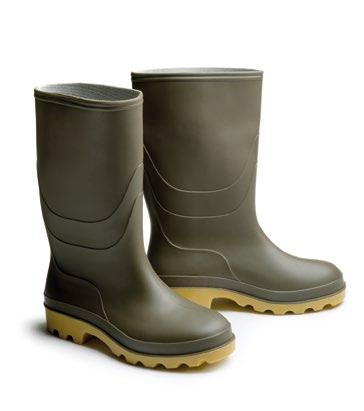
root nourishment.
During a particularly heavy downpour make sure to cover your more delicate plants using a tarpaulin or by moving potted plants to your greenhouse. Capitalise on the free water by leaving out vessels in which to collect the rain, so you can use it when your plants are thirsty without unnecessarily adding to your H2O consumption.
You’ll quickly notice which areas of your garden don’t have adequate drainage from the pools of water that collect. To ensure this doesn’t become a major problem that could drown your hard work, create a proper runoff or trench for the water to escape.
Finally, take advantage of your lovely mint herb as this wonderful plant thrives after a soggy day and will make a very satisfying tea for you to enjoy (indoors!) after all your hard work. n
HOME & GARDEN
112 • NOVEMBER 2019




PERSONALISED NUTRITION FOR THE OVER 50’S
A healthy, well balanced diet combined with exercise is key to making the most of our life in the prime of our life. But many of us are lacking many key micronutrients and therefore supplementation with a well formulated range of supplements is a healthy addition to our diet.
Prime Fifty have formulated and tailored unique supplements that include a combination of carefully selected, scientifically researched nutritional ingredients to combat nutrient deficiencies in the over 50’s and support the health and wellbeing of those in their senior years.
ENERGY SUPPORT
Maintaining energy levels through the day is more and more di cult as we age, so we need to ensure that our nutrition is healthy, as this is a major contributor to how we feel from day to day. Getting those essential B Vitamins is important if we are to ensure that our energy producing metabolism is at its best.
Fighting Fatigue Supplement
30 tablets, 1 month supply: £8.50
BONES SUPPORT
Bone mass decline begins in our late 30’s and significantly speeds up in post-menopausal women, though men do not escape bone loss with age either. Maintaining bone health is vital for movement and strength and this unique formula contains key nutritional ingredients to help your bones remain strong and in prime condition.
Strong Bones Supplement
30 tablets, 1 month supply: £6.50
JOINTS SUPPORT
As we all age, our joints can become sti and give us pain from time to time and in some cases the pain can be considerable. This formula contains not only a combination of the main front line joint health ingredients, but also key micronutrients that have been proven to help support healthy tendons and ligaments.
Healthy Joints Supplement
30 tablets, 1 month supply: £14.00
TO FIND OUT MORE INFORMATION OR TO PLACE AN ORDER VISIT www.primefifty.co.uk/RD or call 07383 443625 Products are UK manufactured to guarantee the very highest quality and safety

Winter Reboot
Lisa Lennkh debates the benefits of stepping into a new winter fashion trend

One of my favourite things about autumn and winter fashion is boots. Not only are they warm and practical to wear, but the right pair can bring elegance and edge to almost any outfit. The new big trend for this winter is a squaretoed boot. We've not seen these since the 1990s, and I find it a particularly tricky shape to wear. It isn't ladylike like a pointed toe, and it isn't sweet like a round toe. It also isn't neutral like the in-between, an almond shaped toe. It's an unusual fashionforward shape.
A square toe does work well with unique and equally fashion-forward clothing (think asymmetrical hem skirts, cropped wide trousers, or loose, retro-style jeans). It also

Lisa Lennkh is a banker turned fashion writer, stylist and blogger. Her blog, The Sequinist, focuses on sparkle and statement style for midlife women
FASHION & BEAUTY
114 • NOVEMBER 2019
completely modernises wardrobe basics; a simple outfit of jeans and a jumper or a tee-shirt immediately looks fresh with a trendy square-toed boot. This is why they've become popular so quickly with the fashion crowd, especially the basics-loving Scandis. They slot into any wardrobe and provide an instant update.
In its perpetual pursuit of novelty, fashion's pendulum always swings to the extremes; after several seasons of serving up knife-edge pointed shoes, designers are now wheeling out the squares. After seeing great success with their quirky square-toed sandals last summer, Balenciaga and Ferragamo debuted extreme squaretoed boots for this winter. There are subtle rounded-square toe boots from designers like Prada and Jimmy Choo. These more wearable styles have already filtered down into high street winter boot designs.
Despite my usual clear opinions on fashion, square-toed shoes and boots are the one trend I'm on the fence about. They can look edgy and interesting, but they also fall perilously close to fashion victim territory. If you're not careful, they can even look a bit ridiculous. With my style and my shape, square toes skew clunky rather than edgy and cool, so I don't wear them. That's perfectly fine. I'm always happy to sit out trends that don't serve me and my wardrobe for the long haul. I'll only buy into a trend if it is
something that works with my personal style. A pointed or almond toe is a much better investment for my wardrobe.
I do have to admit that I'm a little tempted by the shiny red Prada square-toed patent knee boots (So cheerful! So Nancy Sinatra!). The pop
THEY LOOK EDGY AND INTERESTING BUT FALL CLOSE TO FASHION VICTIM
of shiny statement colour speaks directly to my aesthetic. Almost any winter skirt or dress would be immediately improved by wearing these. I could make them work with my wardrobe, but they still aren't as versatile or enduring as a pointedtoe style. If my wallet is going to suffer the Prada price tag, the boots have to have serious longevity!
Despite this being a trend that will date, if square-toed boots work with your wardrobe and your style, they are well worth investigating. Not only are they more comfortable than a pointed toe, but your trusty basics will get a thoroughly modern reboot from adding them to your wardrobe this winter. n
NOVEMBER 2019 • 115 READER’S DIGEST
It Started With A Kiss…
Jenessa Williams teaches you how to master the coveted “gradient lip”
Tired of the classic red lip in your beauty arsenal? Lipstick just got a lot more fun.
Popularised by the Korean Beauty market, gradient lips are the perfectway to get a "just kissed" pout, akin to a natural blush or subtle highlight. Requiring minimal maintenance through the day, this style is great for creating the illusion of a plumped and contoured lip without any stinging serums or fussy tools.
The key is to choose tones that flatter your natural lip colour. Use two shades of lipstick with one slightly darker than the other for a bolder look, or opt for the 2019 method of liquid concealer layered underneath

your desired colour. Paint your concealer as you would a normal lipstick and allow to dry, then apply a small amount of lip tint or liquid stain to the centre of your lip and press gently together, allowing the colour to spread naturally outwards. The fuzzy edge may seem alarming at first, but rub lips together until you get a flush you’re happy with. Add a final flourish with a touch of clear, wet look gloss to perk up the colour and “set” the finish. Mission complete! Don’t blame us if you find yourself under the mistletoe as party season approaches… n
Hero Products



Dr Hauschka Light Reflecting Concealer, £16.95
Revlon Kiss Cushion Lip Tint, £7.99
Bobbi Brown Crystal Lip Gloss, £18.50
FASHION & BEAUTY
116 • NOVEMBER 2019





Brexit Demise of Great Britain
Rulers of One of the World’s Great Powers Go Haywire
Ernie Hasler

www.authorhouse.co.uk
Paperback | E-book
£15.95 | £2.99

An exciting, political thriller, Brexit Demise of Great Britain, exposes many truths and facts. The United Kingdom and the impending Brexit disaster. Including prominent figures in the political world, where the distinction between public service and personal gain is very grey. Although fictional, the story has a ring of truth to those who can perceive double-dealing through the fog of clever propaganda. The book also predicts the collapse of the world fi nancial system triggered by Brexit and the rise of a Religious/ Political World Government.
BRING A NEW STORY HOME WITH YOU TODAY.
ADVERTISEMENT
KNIVES OUT

The whodunnit genre is alive and kicking in this deliciously devious, star-studded romp from Rian Johnson
Daniel Craig becomes the American version of the legendary Detective Poirot in this dark yet playful whodunnit. What makes Knives Out unusual, though, is that we find out exactly who-done-it right at the beginning of the film, turning the genre on its head.
The story is as old as the hills: Harlan Thrombey, the wealthy patriarch of a big, eccentric family dies under mysterious circumstances following his 85th birthday celebrations. Craig’s Benoit Blanc steps in to investigate and sifts through a slew of red herrings to uncover the truth. This, of course,
involves questioning the (sometimes insufferably) colourful members of the Thrombey clan. And while each and every one of them is fabulously compelling in their own way, special mentions go out to Toni Collette’s kooky Instagram influencer Joni, Chris Evans’ James Dean-esque rebel Ransom and Jamie Lee Curtis’ cool and collected Linda. But the star of the show is the victim himself: though we only get to know Harlan (played with great gusto by Christopher Plummer) through flashbacks and other people’s stories, his impish charm and wit are irresistible. While fresh and modern, Knives Out also feels timeless and nostalgic, and is bound to make you reach for the nearest Agatha Christie novel.
READERSDIGEST.CO.UK/CULTURE/FILM 118 • NOVEMBER 2019 © LIONSGATE
H H H H H FILM
DRAMA: SORRYWEMISSEDYOU
Britain’s champion of the oppressed masses, Ken Loach, returns with another downbeat musing on the struggles of the working class. This time, he follows a sweet family struggling to make ends meet: Ricky and Abbie, the parents, fight tooth and nail to keep their family afloat, working to impossible schedules, while simultaneously dealing with their unruly teenage son Seb and their increasingly anxious younger daughter Lisa. If you’ve ever seen a Loach film before, you’ll know

exactly where this is going; the punches will keep on coming until the family— and, inevitably, the audience—reaches a bitter breaking point. It’s an impactful drama, but takes too much pleasure in sermonising for its own good.

COMEDY: JUDYANDPUNCH
If you’re a fan of morbidly hilarious, genre-bending flicks in the vein of Yorgos Lanthimos’ The Lobster, you’re likely to fall for this new Aussie tale about the eponymous 16th-century couple of puppeteers navigating a rocky period in their lives. With its weird, unpredictable tone where hilarity bleeds into tragedy at the drop of a hat, superb performances and shrewd commentary on modern-day society, it’s one hell of a ride.
ROMANCE: NON-FICTIONJuliette
Binoche leads a superb cast in this clever, sexed-up French comedy about a group of bohemian intellectuals inhabiting the toothsome Parisian publishing world. You can tell director Oliver Assayas is a big Woody Allen fan by the way the film emulates his witty dialogue, neurotic tone and alluring affairs; yet he never quite nails Allen’s light-heartedness and absurdism, instead obsessing over minuscule nuances of book publishing and overdone self-references. The flair and style Assayas does it with still make for one scrumptious watch though.
by Eva Mackevic

© ENTERTAINMENT ONE /PICTUREHOUSE ENTERTAINMENT/ CURZON
H H HH
H H H H
H H H H
H
H
H

GIRI/HAJI (BBC2; BBC IPLAYER)
What is it? Darkly comic BBC/Netflix coproduction that dispatches Japanese detective Takehiro Hira to London to investigate a Yakuza-related killing. Why should I watch it? Series creator Joe Barton follows up C4’s Humans with a knowing slice of pulp distinguished by smart location work and an excellent cast.
Best character? The 45-year-old Hira, a veteran of Japanese screen and stage, is a real discovery: a grave, upright presence who often suggests some 21st century reincarnation of Gregory Peck.
CRIMINAL(NETFLIX)
A good season for police drama: Netflix hops round Europe with this ambitious interrogation-room procedural, recruiting David Tennant on its UK layover.
THEHUNTING(CHANNEL FIVE)
What is it? Four-part Australian miniseries unpicking the fallout from a high-school sexting scandal. Why should I watch it? Writerdirector Sophie Hyde makes an assured move into TV with a gripping drama that grasps how technology has shifted the goalposts when it comes to intimacy—opening up a divide between the sexes, as it has between the generations. You’ll emerge thankful you never had cameraphones monitoring your own development.
Best character? An excellent ensemble mine every nuance in these scripts—the youngsters are every bit as compelling in their confusion as the grown-ups.
 by Mike McCahill
by Mike McCahill
WHAT TO STREAM THIS MONTH:
THEFAMILYMAN (AMAZON PRIME) India’s
sparkiest young filmmakers
Raj and DK fashion a goofy, romp about a spy juggling domestic duties with national security.
UBELIEVABLE (NETFLIX)
This tough yet superbly handled true-crime drama miniseries sets detectives
Toni Collette and Merritt Wever on the trail of a serial rapist.
TELEVISION
CHANNEL 5 IMAGES 120 • NOVEMBER 2019
ALBUM OF THE MONTH:
ATHENAby SUDANARCHIVES
It may be Brittney Denise Parks’ (aka Sudan Archives) debut album, but she’s hardly a newcomer, having made a splash with her two previous EPs, Sudan Archives and Sink, setting high expectations for her debut album. It’s safe to say she meets—and exceeds them with effortless panache.

The idea of duality is at the heart of Athena both musically and thematically. Parks tells her story through raw, sincere lyrics that reveal her as both a determined fighter as well as a vulnerable human being who’s experienced her fair share of heartache. Musically, the album is a refreshing revelation in its unique and sophisticated approach to R&B. Parks, who is a self-taught violinist, peppers this traditionally smoky, sensual genre with ferocious strings that cut through the lush, bass-saturated textures like acid. The resulting sound reveals an ambivalent, multi-layered portrait of the artist as she seamlessly moves between ostentatious abrasiveness and all-consuming fear from song to song.
Sudan Archives is destined for big things, so be sure to give Athena a spin to establish yourself as an original fan.
Key tracks: “Did You Know?”, “Confessions”, “Black Vivaldi Sonata”
by Eva Mackevic
READER RADAR: LILY PARKER, UX & BRAND DESIGNER
WATCHING: EUPHORIANOW TV
If Degrassi had been written by Marquis de Sade, this would be it. Social porn, drug abuse, unrequited love and exploratory violence under a beautiful, glossy cover of darkness.

ONLINE: I have steadfastly maintained a lifelong aversion to social media, and prefer to pass the time with live music and strong whisky.
READING: TRANNYBYLAURAJANE
LISTENING: SLAYER The mighty Slayer may have said farewell this year, but their legacy will live forever. “Learn the sacred words…” Plus, anything recommended by Reader’s Digest!
GRACE It may not the most beautifully written book, but I love the raw honesty of her dysphoric journey in the notquite-so-anarchistic world of punk. It would inspire anyone to find their authentic self.
MUSIC EMAIL YOUR RECOMMENDATIONS TO READERSLETTERS@READERSDIGEST.CO.UK
November Fiction
A heartfelt story of three women and their relationship with the younger generation and a dark, timely thriller are our top literary picks this month…

Grandmothers by Salley Vickers (Viking, £16.99)
The biographical section of Salley Vickers’s website isn’t very long—but it still finds room for her “two grandchildren, with whom she spends as much time as she possibly can”. And it’s this unique bond between grandmothers and grandchildren that lies at the heart of her new novel. The three main characters may be very different from each other: toughminded, unsentimental Nan; the rather sweeter (and certainly drunker) Blanche; quietly bookish Minna. Yet, all are at their happiest hanging out with a beloved grandchild.
In less skilful hands, the book’s many

James Walton is a book reviewer and broadcaster, and has written and presented 17 series of the BBC Radio 4 literary quiz
The Write Stuff
storylines might have led to unwieldiness. Vickers, however, depicts each character and relationship with forensic clarity, as well as a touching level of kindliness to everybody concerned. Or almost everybody— because one of the big themes here is the alliance that the old and young often form against those middle-aged spoilsports known as parents, with their mad neuroses about the dangers of unhealthy food, late nights and so on. Now and again, in fact, some of Nan’s pronouncements about the damaging effects of over-anxious parenting perhaps feel too directly like author’s messages. Unfortunately for us middleaged spoilsports, that doesn’t make them wrong.
Kiss the Girls and Make Them Cry
by Mary Higgins Clark (Simon & Schuster, £20)
At this stage in her career, Mary Higgins Clark is beginning to seem not so much a writer as a force of nature. Now 91, and with around 50 bestsellers behind her, she could be forgiven for—at the very least—allowing her novels’ energy levels
BOOKS
122 • NOVEMBER 2019

to dip slightly. Well, not in this one: a richly plotted (and richly sub-plotted) 400-page tale about the impeccably topical subject of sexual abuse by rich, important men.
Gina Kane is a thirty-something investigative reporter, who receives an unsolicited email from Cathy Ryan, a former employee of the huge New York media company REL News, mentioning “a terrible experience” she and other young women have had there. Before Gina can meet her, though, she dies in a mysterious accident…
As ever with Clark, readers who like their thrillers blood-soaked and brutal might want to look elsewhere. Yet, while she and Gina are plainly on the side of the angels, the novel is by no means cuddly. Clark has clearly researched the whole dark business of non-disclosure agreements, and her account of the ruthlessness of big corporations is both heartfelt and convincing.
Name the author
Can you guess the writer from these clues (the fewer you need the better)?
1. He was knighted in the last New Year’s Honours list for services to literature.
2. The heroine of his most famous books was brought up at Jordan College, Oxford.
3. His surname is also the name of a type of railway carriage.
Answer on p126
Paperbacks
It’s All a Game by Tristan Donovan (Atlantic, £8.99).
A history of board games that blends fascinating information with nostalgia. It also explains the role of Monopoly in helping British prisoners of war to escape from the Nazis.
Fantastic Beasts: The Crimes of Grindelwald by JK Rowling (Sphere, £7.99).
The original screenplay for the film— and, let’s face it, bound to be heading the bestseller lists soon.
First You Write a Sentence by Joe Moran (Penguin, £9.99). Clear, lively and example-packed guide to writing well.
Wakenhyrst by Michelle Paver (Head of Zeus, £8.99).
There’s clearly a taste for gothic novels at the moment—and by common consent this is one of the very best.
Devices and Desires by Kate Hubbard (Vintage, £11.99).
Tudor fans will love this vivid biography of the formidable Bess of Hardwick, who married her way to the top of Elizabethan society, building Hardwick Hall along the way.
NOVEMBER 2019 • 123 READER’S DIGEST


The Skin We Live In
A fresh and funny reminder that the human body is the greatest machine of all
Bill bryson is probably still best-known for his funny and charming travel books, such as Down Under and Notes from a Small Island. But over the years he’s proved equally good at something that’s a lot harder to do: funny and charming science books. And in The Body, he proves it again, shaping enormous amounts of solid scientific material in a way that’s always a joy to read—and
RD’S RECOMMENDED READ
The Body: a Guide for Occupants by Bill Bryson is published by Doubleday at £25
where virtually every paragraph contains at least one startling, even awe-inspiring fact.
The book goes through the various parts of the body quite systematically, but it also has plenty to say on the often alarming history of medicine, reminding us how recently some of the most basic truths of human biology were discovered. It also reminds us of how much we still don’t know—including why we hiccup, why we yawn, why we have two kidneys, why we have a chin, why we cry when we’re upset and what 98 per cent of our DNA is for.
Indeed, even our astonishing brains—“the most extraordinary things in the universe,” according to Bryson—haven’t worked out why we have these astonishing brains. After all, there’s no evolutionary need for say, being able to write music or do philosophy. (Incidentally, in
BOOKS
124 • NOVEMBER 2019
one of Bryson’s many myth-busting moments, he also explains that the weirdly widespread idea about how we use only ten per cent of our brains is completely false. Nobody’s sure how the rumour started, but the real percentage is 100.)
In the end, then, it’s not surprising that the book is infused with such an infectious sense of wonder at the miraculousness of it all—as in this passage from near the beginning…
‘‘
We pass our existence within this warm wobble of flesh and yet take it almost entirely for granted. How many among us know even roughly where the spleen is or what it does? Or the difference between tendons and ligaments? Or what our lymph nodes are up to? How many times a day do you suppose you blink? Five hundred? A thousand? You’ve no idea, of course.
Well, you blink fourteen thousand times a day—so many that your eyes are shut for 23 minutes of every waking day. Yet you never have to think about it, because every second of every day your body undertakes a literally unquantifiable number of tasks without requiring an instant of your attention.
In the second or so since you started this sentence, your body has made a million red blood cells. They are already speeding around you, coursing through your veins, keeping you alive. Each of those cells
NO ONE CAN SAY WHY THOSE SEVEN BILLION BILLION BILLION ATOMS HAVE SUCH AN URGENT DESIRE TO BE YOU
will rattle around you about 150,000 times, repeatedly delivering oxygen to your cells, and then, battered and useless, will present itself to other cells to be quietly killed off for the greater good of you.
Altogether it takes seven billion billion billion atoms to make you. No one can say why those seven billion billion billion atoms have such an urgent desire to be you.
They are mindless particles, after all, without a single thought or notion between them. Yet somehow for the length of your existence, they will build and maintain all the countless systems and structures necessary to keep you humming, to make you you, to let you enjoy the rare and supremely agreeable condition known as life.
That’s a much bigger job than you realise. Unpacked, you are positively enormous. Your lungs, smoothed out, would cover a tennis court, and the airways within them would stretch from London to Moscow. The length of all your blood vessels would take
READER’S DIGEST
NOVEMBER 2019 • 125
you two and a half times around the Earth. The most remarkable part of all is your DNA. You have a metre of it packed into every cell, and so many cells that if you formed all your DNA into a single strand it would stretch ten billion miles, to beyond Pluto. Think of it: there is enough of you to leave the solar system. You are in the most literal sense cosmic.
But your atoms are just building blocks, and are not themselves alive. Where life begins precisely is not so easy to say. The basic unit of life is the cell—everyone is agreed on that. The cell is full of busy things— ribosomes and proteins, DNA, RNA, mitochondria and much other microscopic arcana—but none of those are themselves alive.
The cell itself is just a kind of little room to contain them, and of itself is as non-living as any other room. Yet somehow when all of these things are brought together, you have life. That is the part that eludes science. I kind of hope it always will.
More amazing facts from The Body
• We shed around 25,000 flakes of skin a minute—or more than a million an hour.
• Just sitting quietly and doing nothing, our brains process more information in 30 seconds than the Hubble Space telescope has done in 30 years.
• A teaspoon of human blood contains approximately 25 billion red blood cells.
• The average human body contains 25,000 miles of blood vessels.
• The average bacterium lives for 20 minutes.
And the name of the author is…
Sir Philip Pullman author of the His Dark Materials trilogy, whose heroine Lyra Belacqua grows up in alternative version of Oxford, before being caught up in a cosmic war. ’’

• In any three-day period, E. coli can produce more generations than human beings have done in the whole of history.
• There are about 100,000 microbes on every square inch of human skin.
• The amount of electricity happening within your cells is a thousand times more than the electricity in your house.
• At any given time, a quarter of your blood is in your liver.
BOOKS
126 • NOVEMBER 2019

Books That Changed My Life
Caroline Kepnes is the author of You, Hidden Bodies and Providence. You was adapted for Netflix in 2018 and Hidden Bodies will air later this year
 Goodbye, Columbus
by Philip Roth
Goodbye, Columbus
by Philip Roth
I had read American Pastoral about three times and I was so in awe of that book that it intimidated me when it came to my own writing. Then one day it hit me that it wasn’t the first thing he’d written, so I picked up Goodbye, Columbus. It’s amazing to think of Roth, published at 26, and to see how much he grew by the time he wrote American Pastoral. The religious aspect, the relatable characters and the fact that you could have people just be absolutely hysterical was a really calming, influential thing for me. It made me want to write.

Are You
There God?
It’s Me, Margaret
by Judy Blume
I related so much to that character as a young girl. My father was also Jewish and my mother was also raised Catholic. As I got older, I realised that this book was the one that made me understand that the settings of books that I love most are always the interior and the mental landscape. I still come back to this book all the time because of the vulnerability in there. Every time I write now I think about that feeling that you get from some books, that you’ve really been let into the most sacred and quiet corners of someone’s soul.

The Silence of the Lambs
by Thomas Harris
I remember reading The Silence of the Lambs and wanting to live vicariously through Clarice. Every word that came out of Hannibal Lecter’s mouth was so intriguing to me. There’s nothing more terrifying than someone who is intelligent and evil. He had that desire to eat humans, which was awful, but the magic was that he’d then say these really insightful things. I wouldn’t have written anything if I hadn’t read the line, “We covet what we see every day,” in my head. I loved the frightening insights into the possibilities of what’s lurking around you. n
FOR MORE, GO TO READERSDIGEST.CO.UK/CULTURE NOVEMBER 2019 • 127

Smart Phones 101
Ready to upgrade your smartphone? There’s a dizzying range of new features to catch your eye.
Olly Mann takes a look...

Olly Mann presents Four Thought for BBC Radio 4, and the award-winning podcasts The Modern Mann and Answer Me This!
THE FOLDABLE ONE
If you nostalgically recall the sensation of snapping shut a Motorola RAZR, I have glad tidings: the foldable phone is back! When closed, the Samsung Galaxy Fold 5G (£1,900) appears to be an ordinary (albeit plump) smartphone. But open up the magnetic shell, and you uncover a dazzling AMOLED display that instantly supersizes your browsing to 7.3 inches. The cost is eyewatering, and the design has teething troubles (you can still make out the shadow of the hinge inside the screen), but, after years of so-so smartphone evolution, it’s certainly refreshing to see some real innovation.
128 • NOVEMBER 2019 TECHNOLOGY
THE VLOGGERS’ CHOICE
The suffix “Pro”, given to the top-end Macs and iPads used by the creative industries, has never graced an iPhoneuntil now. Apple’s triplelens iPhone 11 Pro (from £1,049) has evidently been developed with YouTubers and Instagrammers in mind: it captures gobsmacking 4K video, boasts increased battery life and comes equipped with newly-simplified editing software. To my eyes, the trio of 12MP cameras result in a rather ugly rearend—Huawei and Samsung’s equivalents are prettier. But, as an all-in-one social media powerhouse, it’s unbeatable.


FORWARDLOOKING, BACKWARDCOMPATIBLE

PLAY-MOBILE
With the Nintendo Switch Lite (£199) proving there’s still a buoyant market for hand-held gaming consoles, Apple are keen to keep gamers glued to their mobile devices instead. Hence, thanks to their iOS 13 update, you can finally sync XBox Wireless (£50) or PlayStation DualShock 4 (£45) controllers to your iPhone or iPad. So, your thumbs can bash away on purpose-built plastic buttons just as happily as when you’re at home, across a range of games from the App Store.
The UK’s first 5G networks are now live, offering blazing fast, latency-reducing mobile internet speeds that will revolutionise our browsing habits as surely as 3G and 4G did before it. But, at the time of writing, there are only eight handsets on the market that actually support 5G (see the list at 5g.co.uk/phones). So, why not access 5G services on your existing devices? The HTC 5G Mobile Smart Hub (£100) creates a Wi-Fi network you can join on your phone, tablet and laptop simultaneously. A £50-£75 monthly subscription to EE’s 5G network is required.
NOVEMBER 2019 • 129
You Couldn’t Make It Up
Win £30 for your true, funny stories!
At the supermarket, a young employee tapped the customer in front of me on the shoulder and said, “Your crackers, madam.”
She turned round angrily ready to give him a piece of her mind, and then realised that he was holding out the bag of prawn crackers that had fallen out of her overloaded trolley.
MAGGIE COBBETT Yorkshire
I was having a difficult conversation about death with my son recently when he optimistically said, “But maybe I won't die.”
“Everybody dies," I told him. He then went quiet for a minute. I thought it was starting to sink in until he came back with, “Father Christmas doesn’t!”
What could I say to that!?
JENNIE GARDNER, Somerset
I gave my dad £50 for his birthday this year, and said he should buy something that would make his life easier. The week after, I asked him what he'd decided upon.
“I bought a present for your mother,” he replied with a grimace.
ALEXA MILLWARD, Flintshire

My daughter came home from school excited. A boy she liked who previously wouldn’t talk to her had spoken to her at last. I was delighted for her and asked enthusiastically what he had said to her.
“Stop talking to me,” she replied.
JOANNA AITCHISON, Cheshire
My nephew was in his wife's bad books recently. She wanted to lose weight and wasn’t succeeding so he advised her to eat naked in front of a mirror, adding that, “Restaurants will always throw you out before you eat too much food.”
SHULAH CLARKSON, Norfolk
cartoons: guto dias
FUN & GAMES 130 • NOVEMBER 2019 Go to readersdigest.co.uk/contact-us or facebook.com/readersdigestuk
I had to suppress a giggle when I saw the church noticeboard recently advertising what the sermon the following Sunday would be about.
The poster read, “What is hell?”
And some wag had written underneath, “Please come early and listen to the choir practice.”
LEON HARDEN, Denbighshire
When I was quite small I asked my mother, “Mummy, do you ever wear trousers instead of skirts?”
She replied, “No, never. Have you ever seen me in trousers?”
I said, “No, it’s just that the last time Daddy's parents were here, I overheard Granny saying to Grandpa, ‘make no mistake about it, she's the one who wears the trousers!’”
DAVID WEBB, Sussex
Our son asked for help with his homework to describe words. His dad helped out but the next day our son was furious with him because everybody had laughed at one of his descriptions. The word was “seizure” but he’d pronounced it “Caesar”, so his dad told him to put down, “A Roman emperor.”
SALI THOMAS, Denbighshire

After having “one of those days”, I decided I needed a treat. So, after shopping, and before a trip to the spa, I bought myself a very unhealthy, definitely-not-slimming, cream cake. I was settling down on the park bench getting ready to eat it, when all of a sudden, a seagull swooped down, knocked it off the bench and dragged it through the mud. I was certain my slimming consultant was in the vicinity controlling that seagull.
JANE SPAMER Devon
I was wondering why a Weight Watchers Club leaflet had been put through our letterbox and our teenage son offered an explanation, “Maybe they had a peep through the letterbox first” he said.
CHLOE WILLIAMS, Denbighshire
NOVEMBER 2019 • 131















YES I want to subscribe to Reader’s Digest Magazine for just £3 for 3 issues (a saving of £8.37 on the shop price of £11.37 based on the cover price of £3.79 per issue). I understand that if I do not wish to continue receiving Reader’s Digest after my first 3 issues I can simply cancel my subscription by contacting customer services. If I do want to continue to subscribe after my first 3 issues I need do nothing and my subscription will automatically be renewed at the low rate of £7.50 for every 3 issues until I decide otherwise.


OCTOBER2019 HEALTH • MONEY • TRAVEL • RECIPES • FASHION • TECHNOLOGY SMALL AND PERFECTLY INFORMED Louis WHEN MAKESHEALTHCARE PEOPLE SICKER “I’ve EnjoyedAlwaysHiding” THEROUX Hospital Horrors MAKES EnjoyedHiding” SEPTEMBER2019 HEALTH • MONEY • TRAVEL • RECIPES • FASHION • TECHNOLOGY READER’S DIGEST SMALL AND PERFECTLY INFORMED The Building Blocks To Mental Health? LEGO Forever Young INSIDETHERACETO Please complete direct debit mandate below Name of Bank ...................................................................... Account Holder Branch: / / Account No Instructions to your bank or Building Society: Pay Reader’s Digest Direct Debits from the account detailed on this instruction subject to the safeguards assured by the Direct Debit Guarantee. I understand that this instruction may remain with Reader’s Digest and if so will be passed electronically to my Bank or Building Society. Signature ..................................................................... Date .............................................................................. INSTRUCTIONS TO YOUR BANK OR BUILDING SOCIETY TO PAY BY DIRECT DEBIT. Originators reference: 400162
Postcode:
Email:
culture,
books, films, food, humour and travel alongside in-depth news features, memoirs and celebrity profiles. It’s never been easier to enjoy the world’s favourite magazine! Sort Code Data Protection: From time to time Reader’s Digest may contact you with details of its products and services. Please tick here if you object to receiving such information Return your completed form to: Reader’s Digest, The Maltings, West Street, Bourne PE10 9PH Or call us today on 0330 333 2220 Quoting code RDN068 FOR JUST £3! Seasonal Savings 7WaysToCurbYour ChristmasSpending MONEY Sir Ian THE LETHAL THREAT OF DRUG RESISTANCE “Older Actors Have AlwaysHadPower” MCKELLEN Antibiotic Crisis NOVEMBER2019 £3.79 readersdigest.co.uk NOVEMBER2019 HEALTH • MONEY • TRAVEL • RECIPES • FASHION • TECHNOLOGY READER’S DIGEST SMALL AND PERFECTLY INFORMED NOVEMBER 2019
Name: Address:
Telephone:
Each must-read monthly issue covers life,
health,
Word Power
Shakespeare’s princely Hamlet is the character who mopes about muttering, “Words, words, words.” Here, from the venerable play by the Bard, are some words (in their root form) you can actively employ today. If, tragically, you need answers, consult the next page
By Emily Cox & Henry Rathvon
1. impetuous adj.—A: full of questions. B: scheming. C: rash.
2. traduce v.—A: shame using lies. B: parry with a sword. C: exchange for a profit.
3. whet v.—A: sharpen or stimulate. B: moisten. C: hasten.
4. rub n.—A: piece of gossip. B: difficulty. C: good-luck charm.
5. germane adj.— A: poisonous. B: relevant. C: ghostly.
6. incorporeal adj.—A: using military might. B: having no body. C: full of tiny holes.
7. wax v.—A: grow smaller. B: grow larger. C: grow a moustache.
8. paragon n.—A: toy soldier. B: five -sided figure. C: example of excellence.
9. calumny n. A: row of pillars. B: disaster. C: character attack.
10. beguile v.— A: bond or form a union. B: deceive. C: leave stranded.
11. felicity n.—A: ill fortune. B: faithful devotion. C: happiness.
12. sully v.—A: answer back smartly. B: drizzle. C: defile or tarnish.
13. malefactor n.—A: masculine quality. B: one who commits an offense. C: swear word.
14. exhort v.—A: dig up. B: overthrow or dethrone. C: urge strongly.
15. quintessence n.—A: most typical example. B: one fifth. C: fluidity in language or spoken word.
NOVEMBER 2019 • 133 FUN AND GAMES
IT PAYS TO INCREASE YOUR
Answers
1. impetuous [C] rash. Jenny has a habit of impetuously hugging strangers.
2. traduce [A] shame using lies. Mia loves to watch politicians traducing each other with bogus statistics.
3. whet [A] sharpen or stimulate. The aroma of turkey was all I needed to whet my Christmas appetite.
4. rub [B] difficulty. Playing truant is easy, but not getting caught—there’s the rub.
5. germane [B] relevant. Your Honour, my client’s nickname—Light Fingers—is not germane to this case of theft.
6. incorporeal [B] having no body. After supper, Grandfather sat us down for a tale of the incorporeal beings supposedly haunting his house.
7. wax [B] grow larger. Noah’s hopes waxed as the rain began to wane.
8. paragon [C] example of excellence. The poet’s vast collection was a paragon of eloquence.
9. calumny [C] character attack. If you can’t win a debate with reason, try outright calumny.
10. beguile [B] deceive. Don’t let the mermaids beguile you with their sultry siren songs.
11. felicity [C] happiness. Nothing could diminish the felicity of the family’s first holiday in years.
12. sully [C] defile or tarnish. It would take only one blowhard to sully the MP's reputation.
13. malefactor [B] one who commits an offense. Upon seeing someone caught by a traffic warden, my dad used to announce, “There goes another malefactor!”
WORD OF THE DAY*
OBLIVESCENCE:
14. exhort [C] urge strongly. The candidate exhorted the crowd to make the right choice come Election Day.
Forgetfulness
Alternative suggestions:
"When you have no idea that your new perfume smells obnoxious"
" Adolescents oblivious to good advice"
15. quintessence [A] most typical example. The human rights activist speaker was the quintessence of humility.
VOCABULARY RATINGS
9 & below: Understudy
10–12: Lead actor
13–15: Master thespian
WORD POWER *POST YOUR DEFINITIONS EVERY DAY AT FACEBOOK.COM/READERSDIGESTUK
134




Reader’s Digest Dating is a safe and secure way to meet a likeminded companion. Specifically designed for singles over 40 who love life and want someone to share it with. It’s free to join and you can sign up in 3 simple steps.
Reader's Digest FIND A LIFE COMPANION WITH readersdigestdating.com
Brainteasers
Challenge yourself by solving these puzzles, then check your answers on p139
Rectangles
Subdivide the area along the gridlines into non-overlapping squares and rectangles. Each of these rectangles or squares must contain exactly one number that indicates how many cells make up its area. Can you draw the right boundaries?
People of Letters
Ram has a box containing 26 books, each one written by an author whose surname begins with a different letter of the basic Latin alphabet. He plans to draw five books randomly out of the box and display them in alphabetical order (by the authors’ surnames) on the display stands shown below. As you can see, he’s already drawn and placed two of them. He now takes out one by Selma Lagerlöf. In order to minimise the likelihood of being forced to move books to different stands as he goes along, where should Ram place it?
136 • NOVEMBER 2019
(Rectangles) F R ase R s impson; ( p eople o F l ette R s) s ue Doh R in. 4 8 7 12 6 3 5 6 9 8 12 JACQUES DERRIDA
VIRGINIA WOOLF
Path Puzzle
Draw a path that leads from one of the grid’s openings to another (there are four openings, so you’ll need to figure out which two are part of the solution). As the path winds from one cell to the next, it can move up, down, left or right but not diagonally. It cannot pass through any cell more than once. The numbers tell how many cells the path passes through in the corresponding rows or columns. Can you trace it?
Decking of Cards
Mark each of the cards in the diagram to the left as one of the following:
All the cards should be used, but no two cards that are next to each other should share a rank or a suit. Some of the suits and ranks have been filled in for you.
Str8ts
Fill in the white cells with whole numbers between 1 and 9 so that no number repeats in any row or column. Blue cells divide the rows and columns into “compartments.” Each compartment needs to contain a “straight.” A straight is a set of numbers that have no gaps between them but that can appear in any order (for example, 2, 3, 5, 4). A clue in a blue cell removes that number as an option in the cell’s row and column, but it is not part of any straight.
FUN & GAMES NOVEMBER 2019 • 137
A , A , A 2 , 2 , 2 3 , 3 4 ( p ath p uzzle) Ro D e R ick k imball; (Decking o F c a RD s) Da RR en Rigby; ( s t R 8ts) Je FF Wi DD e R ich. 9 5 4 6 2 1 8 7 6 3 4 8 6 2 1 2 4 5 6 3 1 5 8 A 1 2 3 3 2 0 2 5 2 2
CROSSWISE Test your general knowledge. Answers on p142 ACROSS 9 Capital (5,4) 10 Maxim (5) 11 Femoral region (5) 12 Comparison standard (9) 13 Unusual (8) 14 Botch (6) 15 Snug (4) 17 Prepares for publication (5) 19 Homework (4) 22 Order to come (6) 23 Comfortable piece of furniture (8) 25 Misunderstanding (9) 27 Paddled (5) 29 Burdened (5) 30 Form of hypnosis (9) DOWN 1 Expel (4) 2 Choice (6) 3 Bow and arrow skill (7) 4 UK biscuit brand (8) 5 Tolerate (4) 6 Serious collision (5-2) 7 Longitudinal fuselage component (8) 8 One who maintains accounts (10) 13 Easy to reach (10) 16 An unspecified person (8) 18 Hare beater (8) 20 Perfumed toilet water (7) 21 Film: “The Hunt for Red ---” (7) 24 Apprehensive (6) 26 Gammy (4) 28 10 US cents (4) BRAINTEASERS 138 • NOVEMBER 2019




THE FIRST CORRECT ANSWER WE PICK WINS £50!* Email excerpts@readersdigest.co.uk Can you name each well-known comedian and match him with his correct middle name (shown below)? ANSWER TO OCTOBER’S PRIZE QUESTION (32+2) x (16+8) + 4 + 1 = 821 BRAINTEASERS ANSWERS £50 PRIZE QUESTION AND THE £50 GOES TO… GAY JACKLIN, West Sussex READER’S DIGEST Rectangles People of Letters On Stand #3. Path Puzzle Decking of Cards Str8ts 4 8 7 12 6 3 5 6 9 8 12 7 8 9 5 4 6 2 1 9 8 7 5 6 3 1 2 8 9 6 7 3 4 7 6 3 2 5 4 8 6 5 1 2 3 4 4 1 3 2 5 7 3 2 4 7 8 5 6 4 3 2 1 8 6 9 7 5 3 2 5 8 9 7 6 A A 4 3 3 2 2 2 A 1 2 3 3 2 0 2 5 2 2 Hawthorne Joel Norvell Spencer a F a R chive / a lamy s tock p hoto A C D B
Laugh!
Win £30 for every reader’s joke we publish!
Go to readersdigest.co.uk/contact-us or facebook.com/readersdigestuk
An elderly lady pays a visit to her doctor and says, “Doctor, you know how you told me to avoid climbing the stairs as much as possible?”
“Yes,” the doctor nods, “we agreed on that after your last X-ray.”
“Well I don’t know that it was such a good recommendation,” she replied. “All that shimmying up and down the drainpipe is getting exhausting.”
Seen on Facebook
I asked a guy the time earlier and he said, “It’s three o’clock you stupid idiot”.
I think that was Greenwich Mean Time.
Comedian DAVID GREEN
If I ever have to film a nude scene, all I’d want is to be in just goodenough shape that nobody calls me “brave” for doing it.
Comedian ALI WONG
I got locked out of my email account today and I had to answer a few of those security questions. The problem was that I made my account while I was still in school.
There is nothing sadder than sitting at your computer for 20 minutes, trying to remember all the dreams you once had.
Comedian JEREMY SMILES
My childhood bully messaged me over social media to say that he feels bad for what he put me through in school.
I said, “Hey, it’s made me the man I am today.”
“Thanks,” he replied. “Now I feel even worse.”
Comedian DAN ROULETTE
140 • NOVEMBER 2019
FUN & GAMES
The past is like a foreign country: ENGLISH PEOPLE ruining it for everyone else.
Comedian ALEX KEALY

Most modern women don’t know what hiking really means. To the average young woman, hiking means waking up whenever you want, putting on the yoga pants that make your rear end look unreasonably good, going for a walk in the park with your best friend and complaining about how hungover you are. That’s hiking.
Comedian ILIZA SHLESINGER
My partner and I have begun to long for the pitter-patter of little feet—so we bought a dog.
Well, it’s cheaper, and you get more feet.
Comedian RITA RUDNER
Remember how when we were children, girls would play house? They’d fake vaccuming with their friends, and it would be awesome. It’s great because it means I can look at my wife now, and know she’s living her childhood dream.
Comedian NATE BARGATZE
A PAINTED SMILE
These famous paintings have been given a cheery makeover using the AI app, FaceApp
(via boredpanda.com)



NOVEMBER 2019 • 141
I’m all about girl power and everything, but when I get married I’m definitely not going to work anymore. And I’m not going to diet anymore. When I say, “I do”, I’ll really mean, “I’m done.”
I’m going to eat whatever I want and fulfil my destiny which is to turn into a circle with eyelashes. Like Mrs Pacman.
Comedian ALI WONG
Two Irishmen on a visit to Rome went to a bar, asked for two beers and were stunned when they were told the bar didn’t have any. When they asked what the Pope drank they were told “Benedictine”, so they asked for two pints of that.
As they neared the end of their drink one said to the other “Now I know now why the Pope is carried in a chair!” JOHN HARKIN, Derry
My roommates and I bought a couch off Craigslist. Turns out, if you play your cards right, you can also get the seller to deliver it to your doorstep. That’s right. Not only did we get a couch for a decent price, but we also told a stranger where we live and that we’re too weak to carry a couch let alone defend ourselves.
Comedian SIERRA KATOW
As a British-Asian kid, I used to find fancy dress parties really difficult.
A child just can’t be the life and soul of the party dressed up as Channel 4 News’s Krishnan Guru-Murthy. Comedian KAI SAMRA
CROSSWORD ANSWERS

SCARILY FUNNY
Twitter users share stories of their strangest Halloween:
@GumGumerson: A trick-ortreater once showed up at my door in a poncho that had the name “John” written on it. When we asked what he was, he said, “I’m John”.
@PunkReckless: I was at a party dressed as a fortune teller. A guy asked me to read his palm, so I told him he’d get drunk and have a good time. He came back an hour later and told me I was “the real deal.” Then he fell over a table.
@MattLong1: I once got so drunk at a Halloween party that when I got home, I egged my own house.
@RealAmieJoe: We rang the doorbell of a house and the guy inside was drunk. He had no idea it was Halloween, so he just gave us all a pound and then turned off his lights.
Across: 9 Upper case, 10 Motto, 11 Thigh, 12 Yardstick, 13 Abnormal, 14 Bungle, 15 Cosy, 17 Edits, 19 Prep, 22 Summon, 23 Armchair, 25 Imbroglio, 27 Oared, 29 Laden, 30 Mesmerism.
Down: 1 Oust, 2 Option, 3 Archery, 4 Maryland, 5 Bear, 6 Smash-up, 7 Stringer, 8 Bookkeeper, 13 Accessible, 16 Somebody, 18 Tortoise, 20 Cologne, 21 October, 24 Afraid, 26 Lame, 28 Dime.
LAUGH
142 • NOVEMBER 2019
60 Second Stand-Up
We chat to the dynamic comedian, Chris Ramsey
WHAT INSPIRES YOUR COMEDY? Life. Family, my friends, my son, my wife. And owning my own embarrassments.
DO YOU FIND ANY PARTS OF THE COUNTRY TO BE FUNNIER THAN OTHERS? No. It honestly all depends on the night and the crowd. It’s like audiences everywhere all over the country are constantly on shuffle. My hometown is where I like performing the most but there’s no way I would say they’re better, I just know them.
DO YOU HAVE ANY FUNNY TALES ABOUT A TIME YOU BOMBED ON STAGE? When I first started, I got bumped up to a paid spot when I wasn’t ready. I was supposed to do 20 minutes and after 12 minutes it went silent, bar some booing. I put the mic back in the stand and I said “This is not going well, sorry. I’m going to go now.” A lady tried to help but made it worse by shouting, “Stay on sweetheart, you’re doing fine,” people probably thought I brought me mam along.

WHAT’S YOUR FAVOURITE OF YOUR OWN JOKES? I’ve got a story in my special about when I auditioned for the film War Horse and it didn’t go well. It’s 100 per cent true and people have trouble believing I could be that stupid.
IF YOU COULD HAVE A SUPERPOWER, WHAT WOULD IT BE? Teleporting would be so helpful. I could introduce my support act, teleport home, put my son to bed, teleport back, do the gig, teleport back and go to bed. I’d never use a hotel again, it would be amazing!
WHAT’S YOUR FAVOURITE ROUTINE?
Billy Connelly during the incontinence routine that he performed on An Audience With in the Eighties. He’s mimicking a guy dancing at the disco with all the confidence in the world because he’s got his “incontinence pants” on and he’s p****d himself while he’s dancing. n
Chris Ramsey: Approval Needed is available on Amazon Prime Video now
FOR MORE, GO TO READERSDIGEST.CO.UK/INSPIRE/HUMOUR
NOVEMBER 2019 • 143
Beat the Cartoonist!
Think of a witty caption for this cartoon—the three best suggestions, along with the cartoonist’s original, will be posted on our website in mid-November. If your entry gets the most votes, you’ll win £50.

Submit to captions@readersdigest.co.uk or online at readersdigest.co.uk/fun-games by September 7. We’ll announce the winner in our October issue.
September’s Winner
Our cartoonist will have to endure another month without his crown as his caption, “What do you mean, ‘Did I try anything funny?’ ” couldn’t compete with our reader, Kelvin Jay who won voters over with his witty suggestion, “You are taking me seriously, aren’t you?”
Congratulations, Kelvin!

In the December Issue

I Remember: Ken Loach
The esteemed British director of Kes and I, Daniel Blake looks back on his eventful life and impressive career

Dreaming of a Greek Christmas
CARTOONST: BILL HOUSTON
For Cypriots, Christmas means a celebration of family, food and blended traditions
KING TUT’S FINAL TOUR
A behind-the-scenes look at Egypt’s bestknown Pharaoh’s final trip round the sun
LAUGH
+ 144
As seen on TV

forPricesheld 2years!
The fuss-free direct cremation that saves 60%* of the cost of a funeral
Pure Cremation is the simple, low-cost alternative to a traditional funeral. We look after the cremation, leaving you free to say goodbye your way.
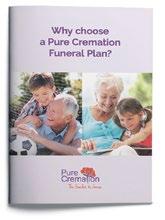
CALL TO REQUEST YOUR FREE GUIDE
We can help you in two ways:
● Take out a cremation funeral plan
● Arrange a cremation now
Call our friendly team today on 0808 501 6262 or visit: purecremation.co.uk/digest


*Sun Life Cost of Dying Report 2018. For full terms and conditions please visit our website. Calls to this number may be recorded for monitoring and training purposes.
RD0819







































 Photo@TaliaFrenkel/AmericanRedCross Haiti 2010
Photo@TaliaFrenkel/AmericanRedCross Haiti 2010











































































































































































































































































































































 Author, Nigel Gray – ‘ Snapshot ’
Author, Nigel Gray – ‘ Snapshot ’




























 by Mike McCahill
by Mike McCahill









 Goodbye, Columbus
by Philip Roth
Goodbye, Columbus
by Philip Roth























































